Welcome back everyone! A hugely productive three weeks this time around with a ton of new graphics, a new of new quest stuff, a ton of updates and improvements over existing features, and I think it’s all pretty fantastic, honestly. Firstly though, here’s the updated current status of 0.11’s development, where BLUE denotes something finished and GREEN denotes something currently being worked on. I have updated this significantly since the last time I posted it, with more completions, and more stuff being worked on:
ITEM INTERACTIONS
- You can drop items
- You can pick items up
- You can use items (whatever that means for the item in question)
- You can throw items
- You can destroy items (very rarely an item might have something hidden inside it…!)
- You can show items (e.g. to someone else)
RELIGIONS
- Generate the images for all 25+ archetypes of religious relics, and place them in religious buildings
- Update and transform things like religious beliefs, things religions dislike, information about religious histories, holy books, etc
- Enable the player to join and leave a religion
- Donating items to religions and receiving items back in exchange from religions
- Far more complex interactions with priests, generating religious staves, etc
- Develop proper model for “membership” in religions, nations, cults, etc
QUEST THREAD FROM START TO END
- Treasure maps spawn in shops just like non-treasure maps do
- Zoomed-out treasure maps correctly show relevant locations
- Non-treasure maps of various types (islands, shipwrecks, caves, etc) spawn
- Zoomed-in treasure maps correctly show relevant locations (far more complex)
- High-value items are, indeed, under the ground where a map points!
- Player starts the game in universities rather than in a capital city
- Initial riddle generation gives enough pieces for one complete thread to be followed
OTHER STUFF
- Implement procedurally generated statues of many types
- Implement aging, death, diseases, health, statuses
- Implement weather and phases of the moon
- Upgrade speech generation and conversation system
- Generate hand images for all NPC showing injuries, tattoos, scarifications, etc
MORE OPTMIZATIONS / BUG FIXING / POLISHING
- Purge all known bugs (current count: 192 resolved)
- Further speed up map generation
- Further speed up turn-by-turn rendering
- Try to speed up world generation as well?
And now, let’s get to the new stuff:
Staves
So it turns out I wasn’t quite done with religions just yet. I’ve now added a number of really, really cool generators for creating unique staves for each religion which priests, abbots, and (later) religious leaders and inquisitors will carry with them (the average believer will not, and the average monk in a monastery will not, as they are presumably too busy illustrating a manuscript to lug around a great big staff). For those who do carry them, however, these now spawn in one of the hands of priests and abbots. There are essentially five major categories of religion in the game – demonic, Lovecraftian, animal, pantheon of gods, and “normal” gods (whoever is left over) – and each of these has their own generator. I’ve got to be honest, I think these really look incredibly cool. Here are two examples for “normal” gods, to begin with, which all select an interesting shape and a religion-appropriate colour, and then add in a few extra symbols, and every now and then something dangling from them, like wind chimes or coloured beads…
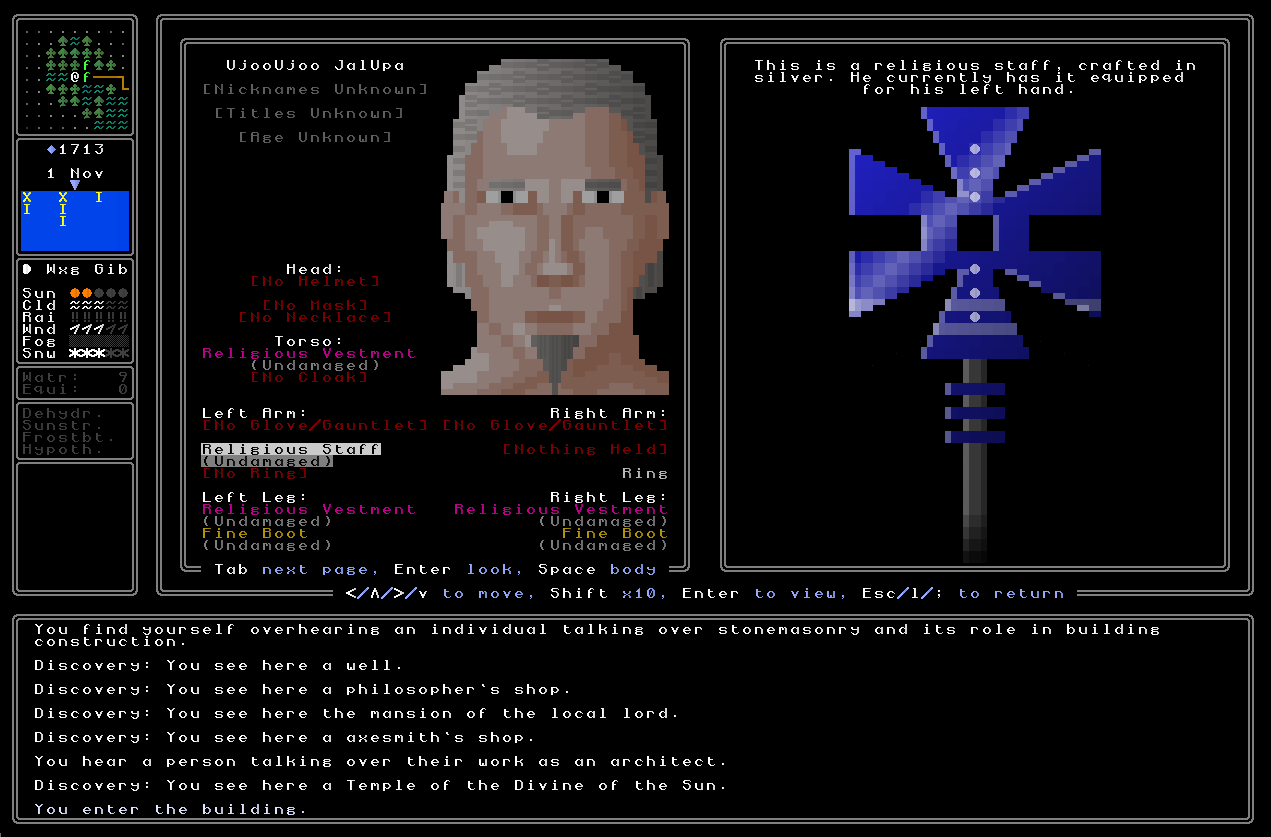
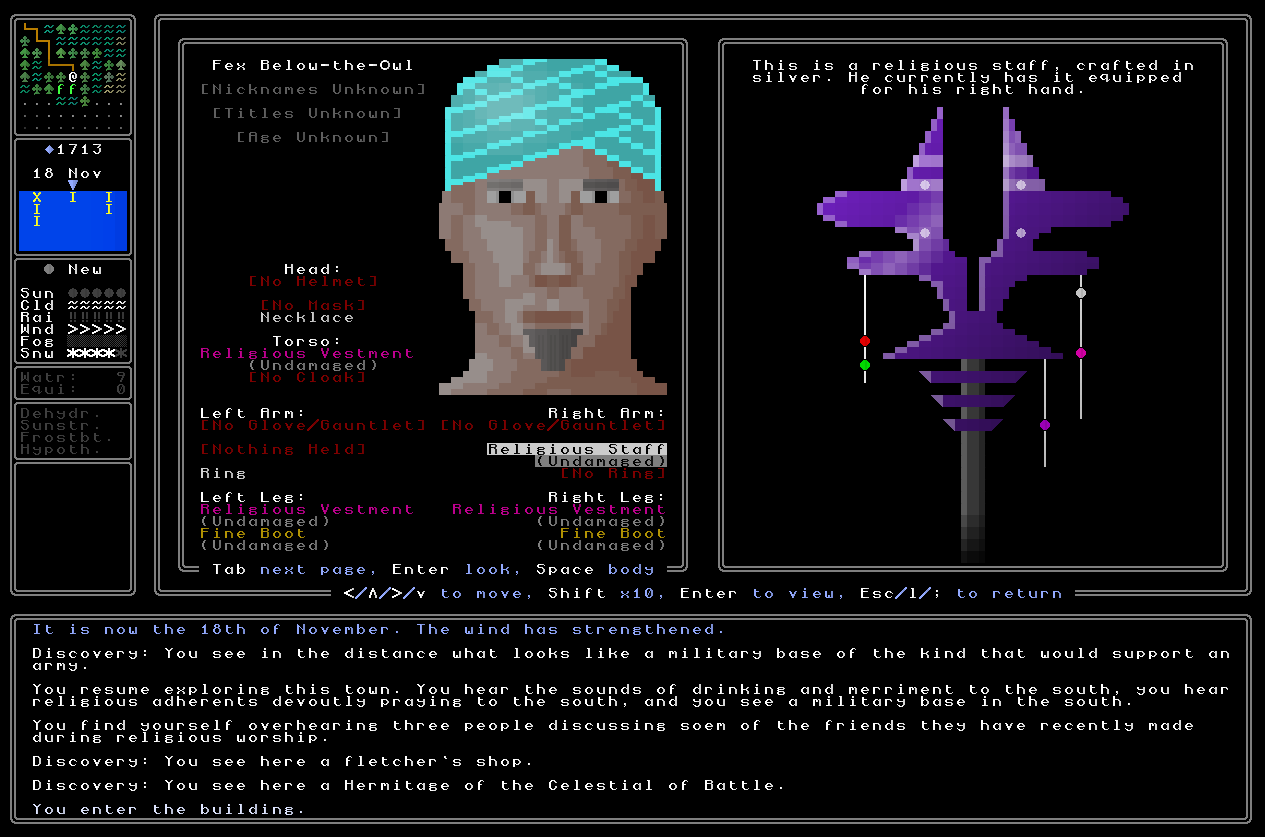
…while here are two examples from two demonic gods. Whereas any normal god can generate any possible staff from the set of possibilities given to those gods, the demonic gods are a little different. Some demonic gods with particular words in their names will spawn special variations, while those who do not will select from a variable pool of more generic options. So, for instance, here is a religious staff for a generated god named The Winged Defiler of the Pure…
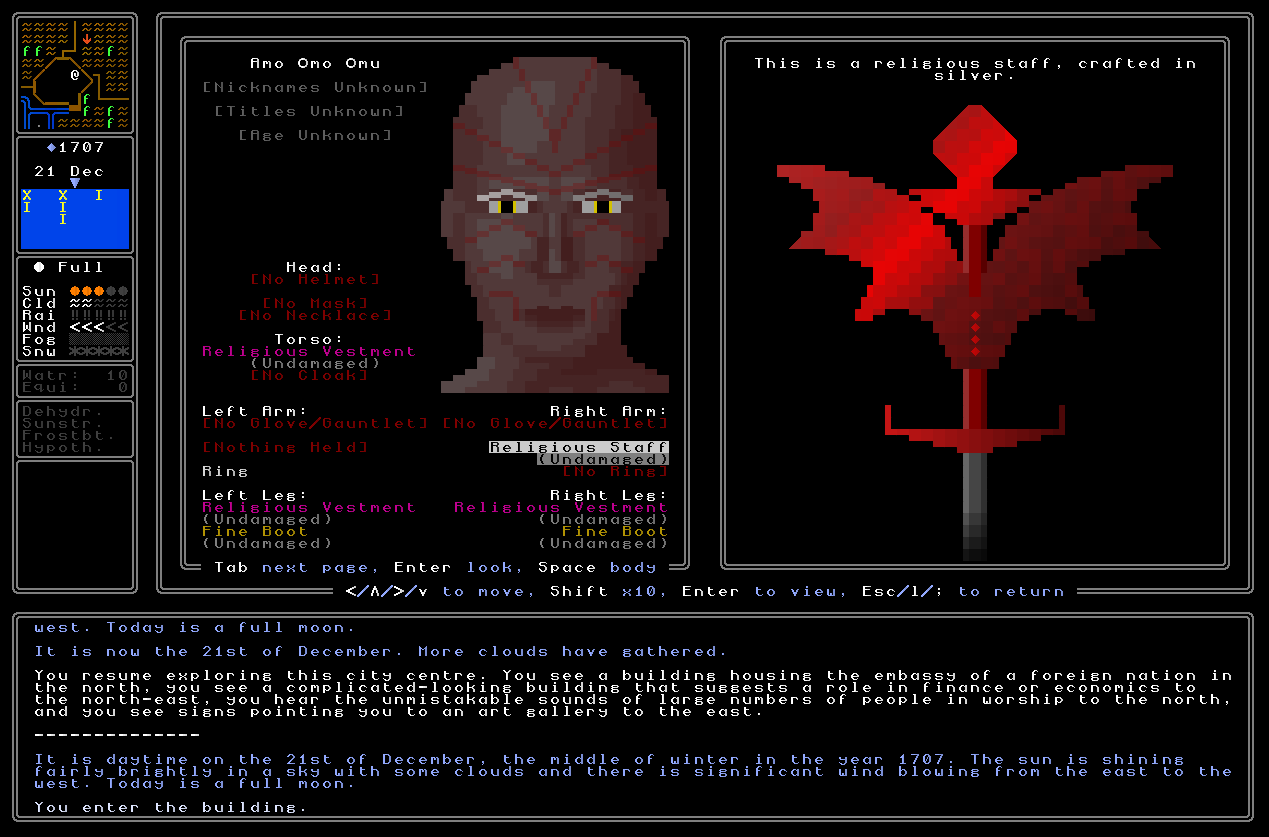
…and one for a generated god who might perhaps, instead, be called The Taloned Render of the Flesh…
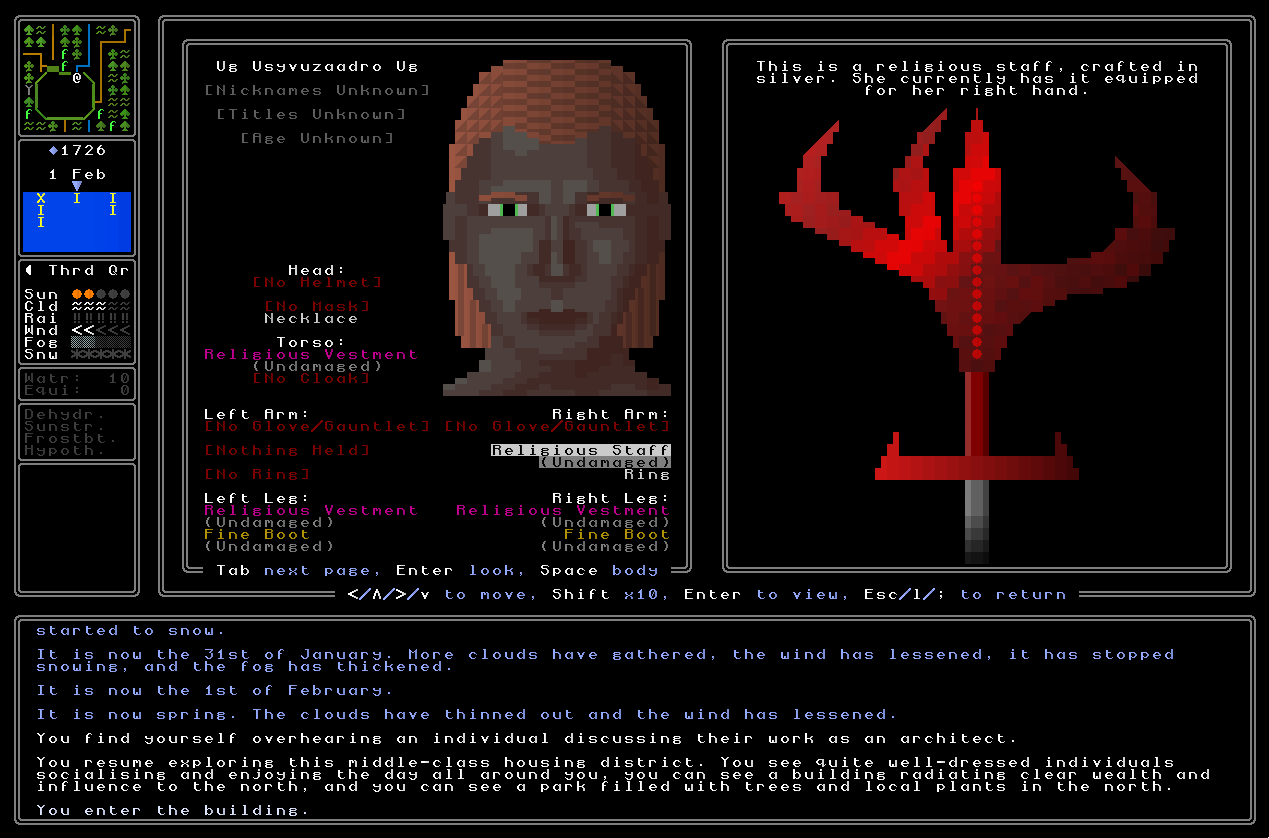
…and then, for perhaps The Lord of the Inferno, a different and more general pool is used instead because there isn’t a word in his name that triggers another option / generator-within-a-generator:
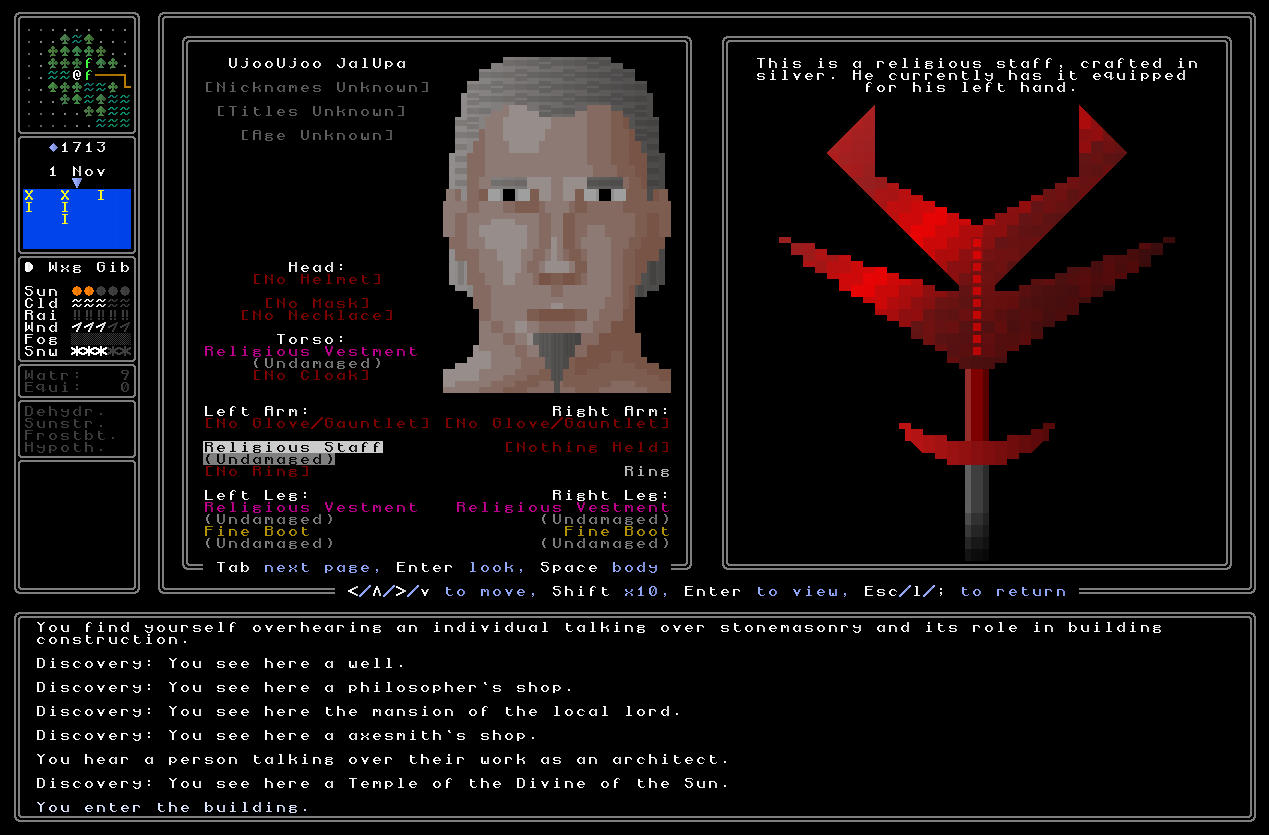
On both of these sets of staves, the small shapes on the staff relate to the aesthetic / shape preference of the nation that spawned the staff, so even staffs within a given religion will also have some distinct differences and variations. Next, we move onto the staffs for the animal gods. These were tricky as I didn’t want to just repeat the animal face again – as we have on the altars, and the statues, e.g.:
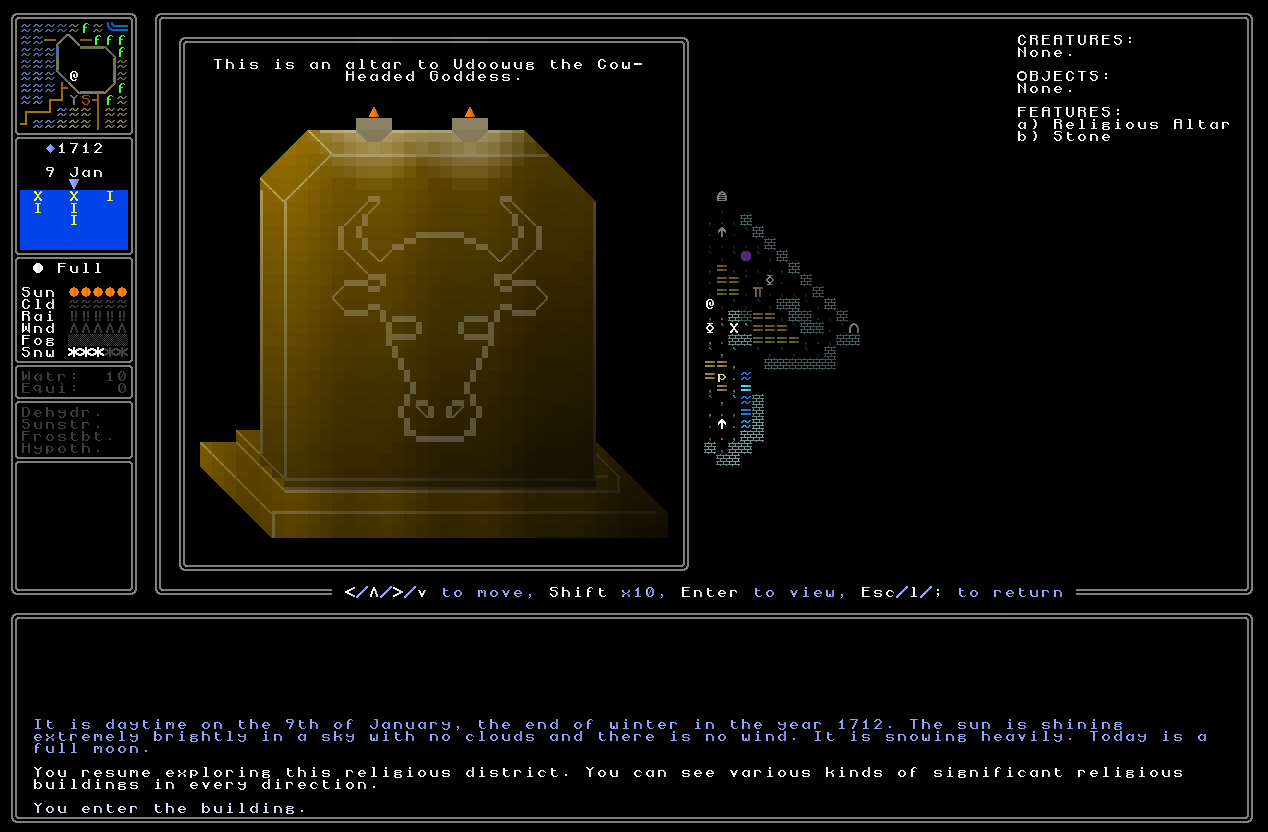
…and so instead I decided to lean into the thin lines aesthetic we see on the altars, and to instead give them a different shape and design of religious staff which emphasizes this aspect. Here, therefore, are two possible generated animal-god religious staves:
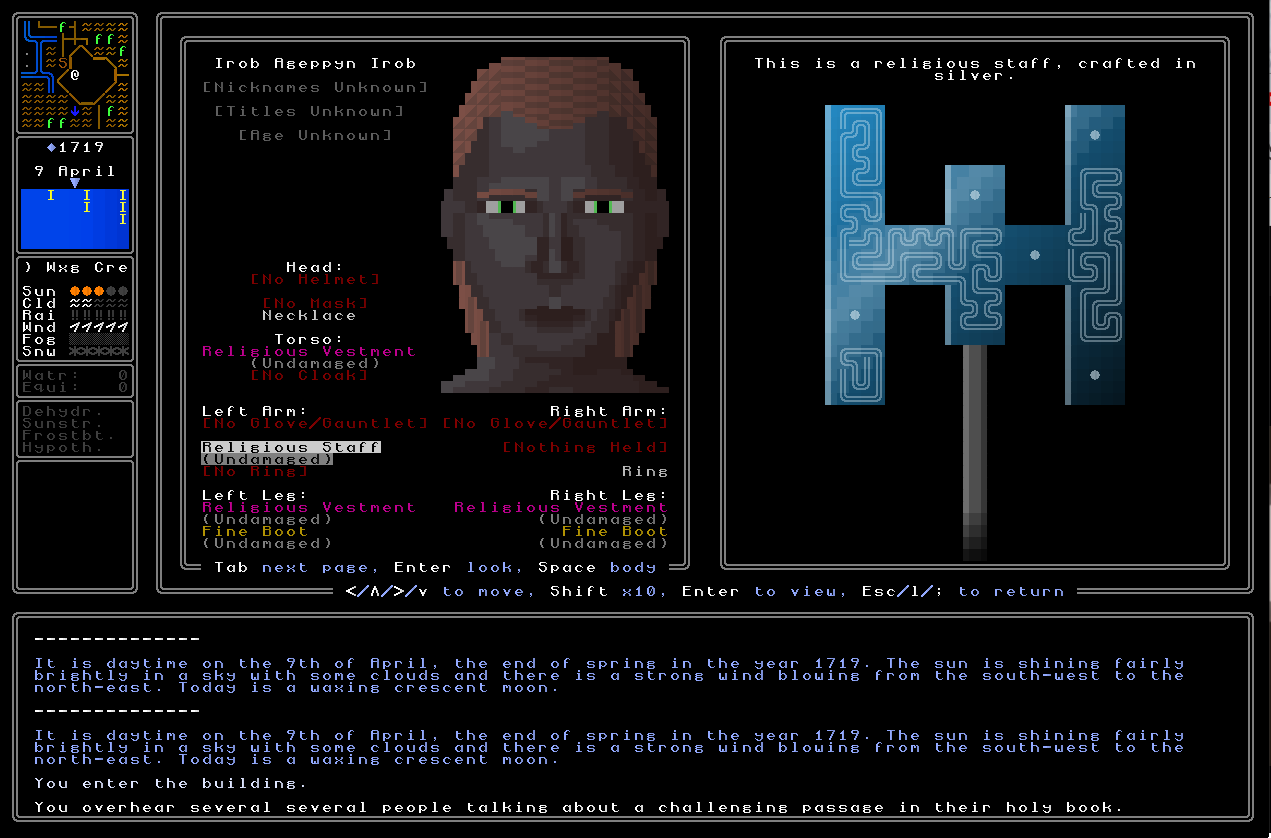
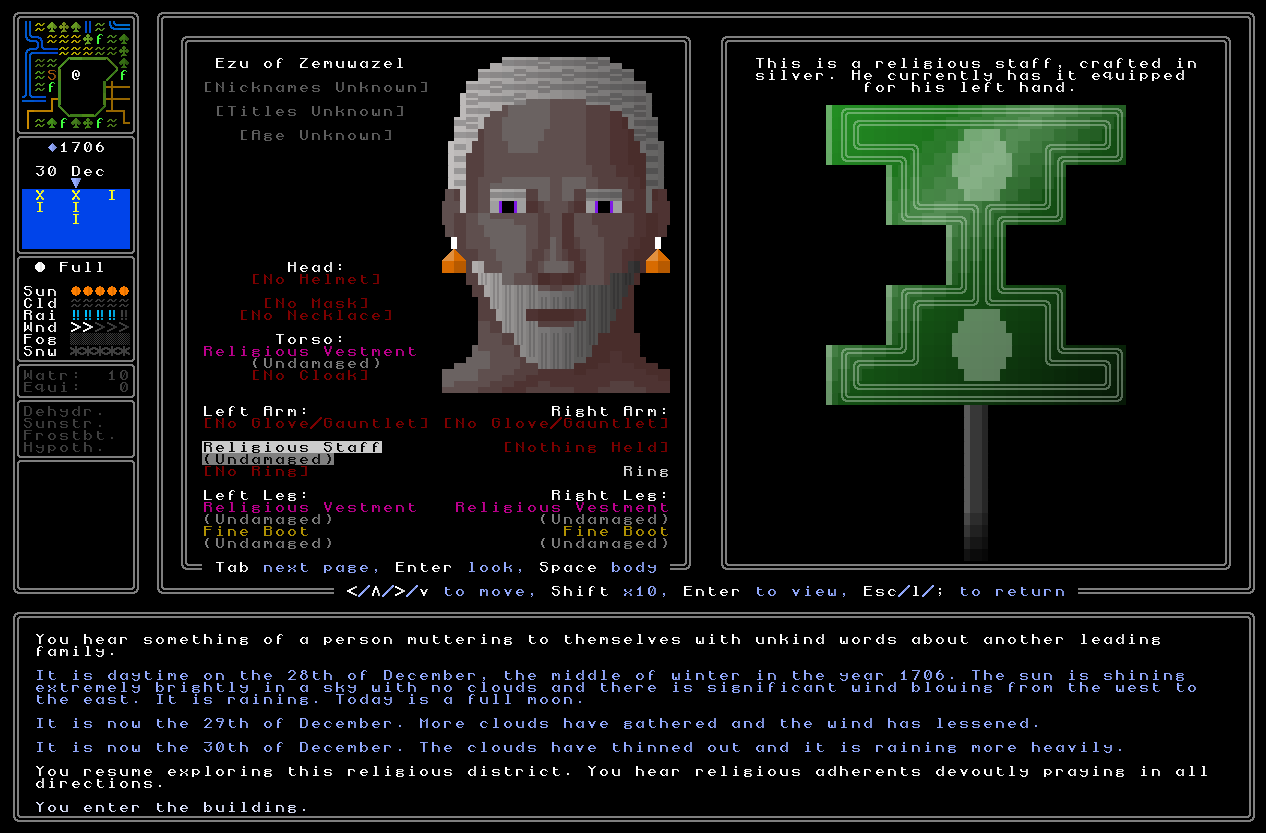
Then we come to the Lovecraftian religions. These were again tricky as I wanted to really distinguish these very significantly from the others. My first initial thought was to have five sets of possible designs for the five possible categories of Lovecraftian gods which can appear, but after playing around with these I just didn’t really like what they were producing. Instead, then, I decided to emphasise spirals – as we all know spirals are dreadful, unearthly, eldritch things – and have again a shape to do with the nation that the priest is a priest in. The colour then, of course, is dependent on the colour selected for that god’s altars, vestments, blah blah. Again, really love how these have turned out! Here are two examples of what this generator can produce:
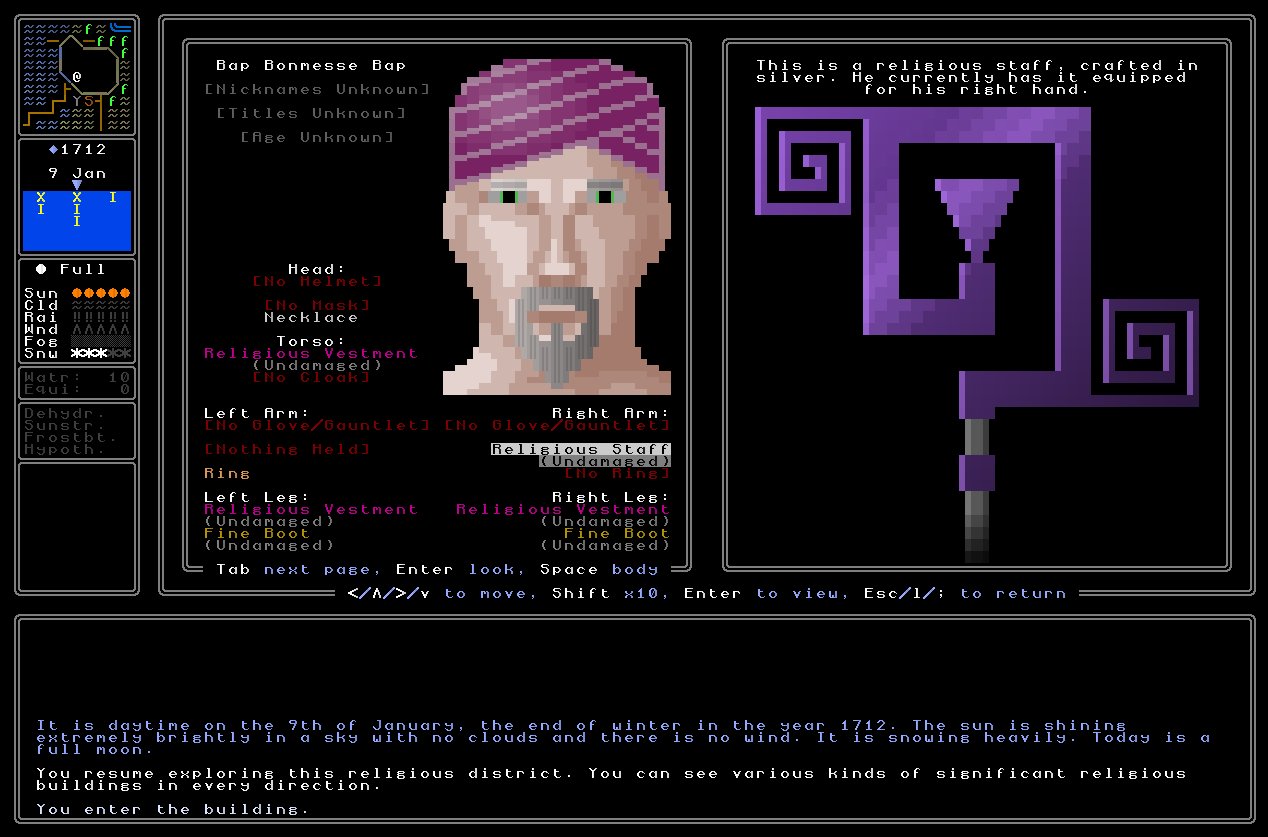
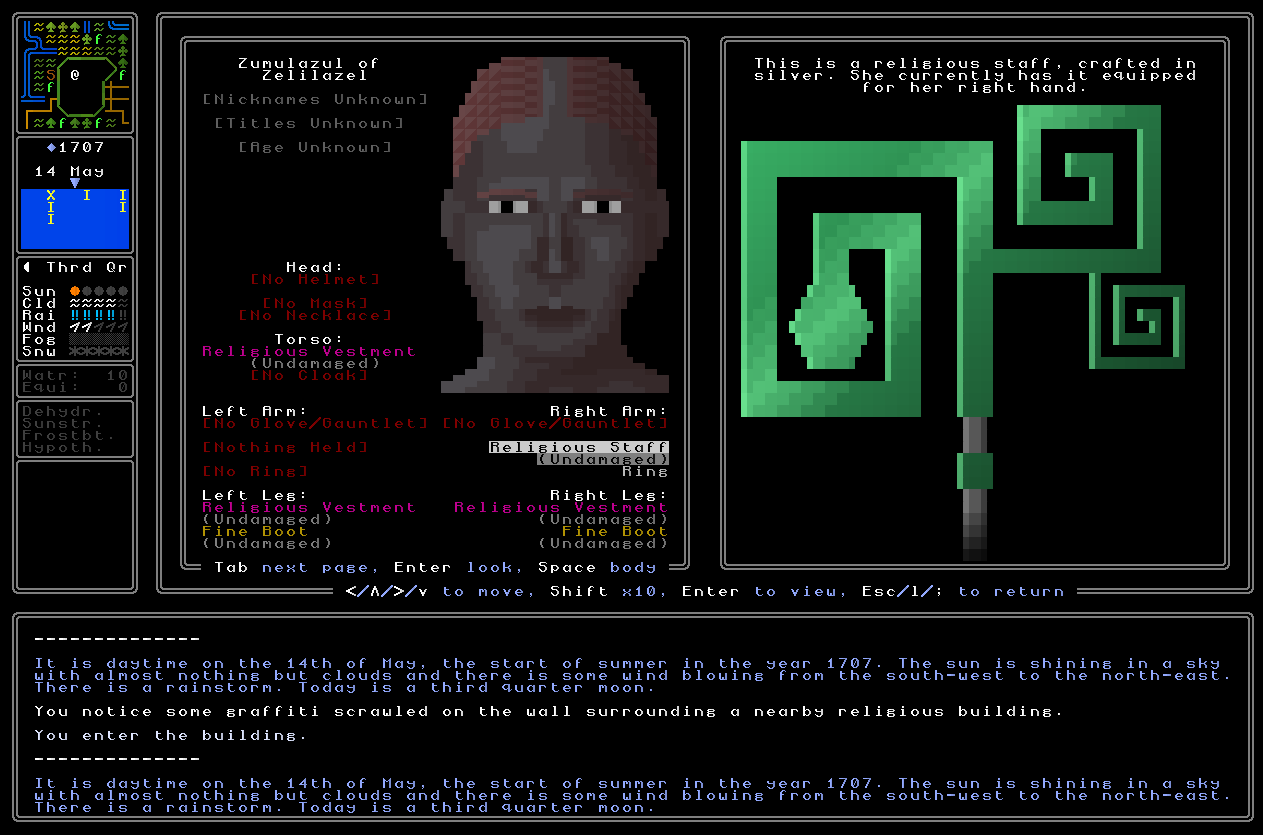
And lastly, here are the staves for pantheons of gods. These pantheons can be focused around various topics – alchemical substances, elements, the cosmos, things of this sort – and so what these staves do is to take the number of gods in this pantheon, select an appropriate shape on which to represent each of these things, and then add some little icons to highlight the nature of each of the gods in the pantheon. This is the rarest category, as you’ll never see more than 1 of these per game (while demonic, Lovecraftian, and animal gods are all 1 or 2 each game), but again I’m happy with how these look. They’re nicely different and nicely distinct from what the others bring to the table. Here’s an example of a five-part pantheon’s (worshipping gods of the sun, the moon, the stars, comets, and planets) religious staff:
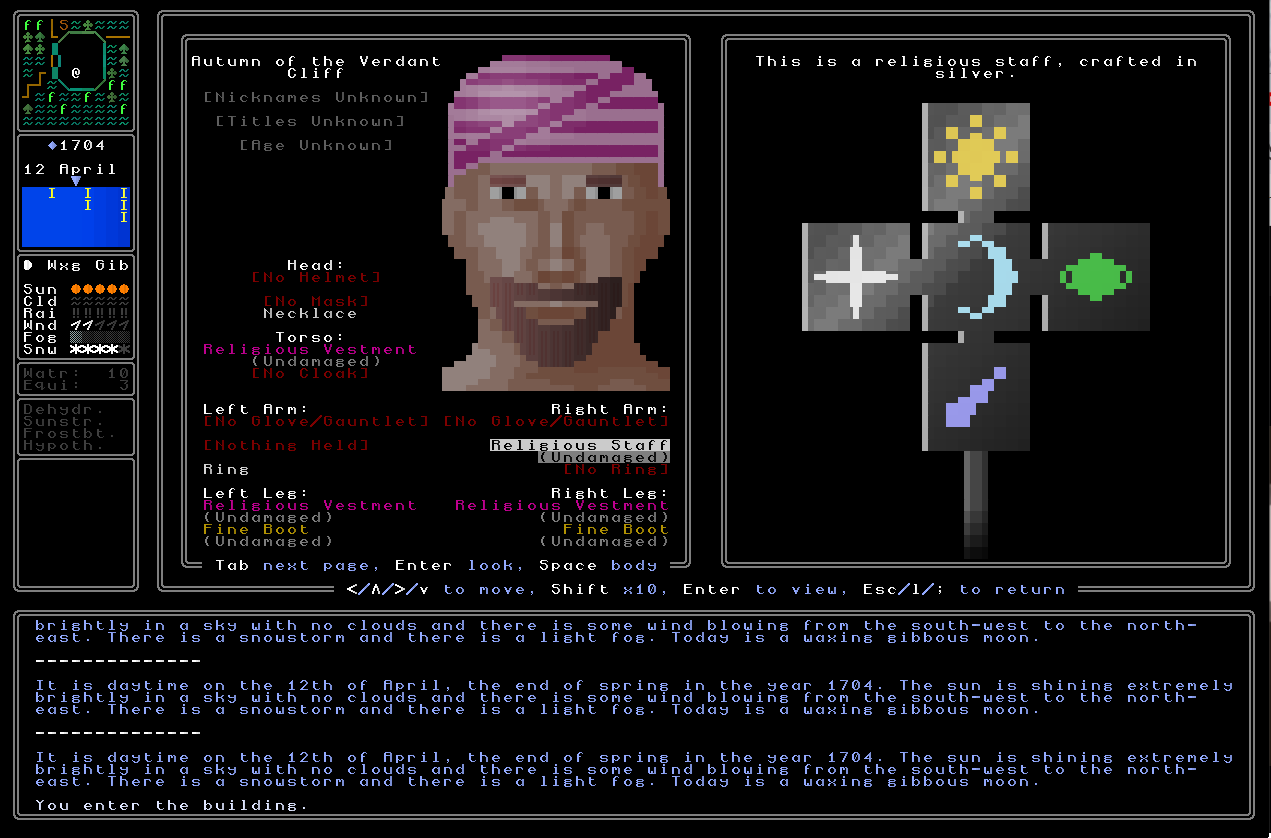
So there we go! As I say, priests and abbots now spawn with these equipped to one of their two hand / arm slots, and I think these again add some lovely extra detail, add the potential for more potential clues and riddles (“He carries a great winged staff…” or “She holds a symbol of seven parts” for hinting towards particular NPCs), and frankly just look really cool. I’ve been struggling a little with a really demanding job at work recently and working on these have been a really rewarding and relaxing break from some of the more brain-bending aspects of this particular task, and I’m very pleased with how they came out. Oh, and they will also have some use in combat (for blocking or slow but heavy attacks), and in the actually now not-too-distant future (!!), I can see a lunatic inquisitor, or zealot, barreling down at the player, swinging one of these religious staves in one hand and a drawn sword in the other, eyes burning with religious fervour…
Conversation system
We now come (back) to the conversation system.
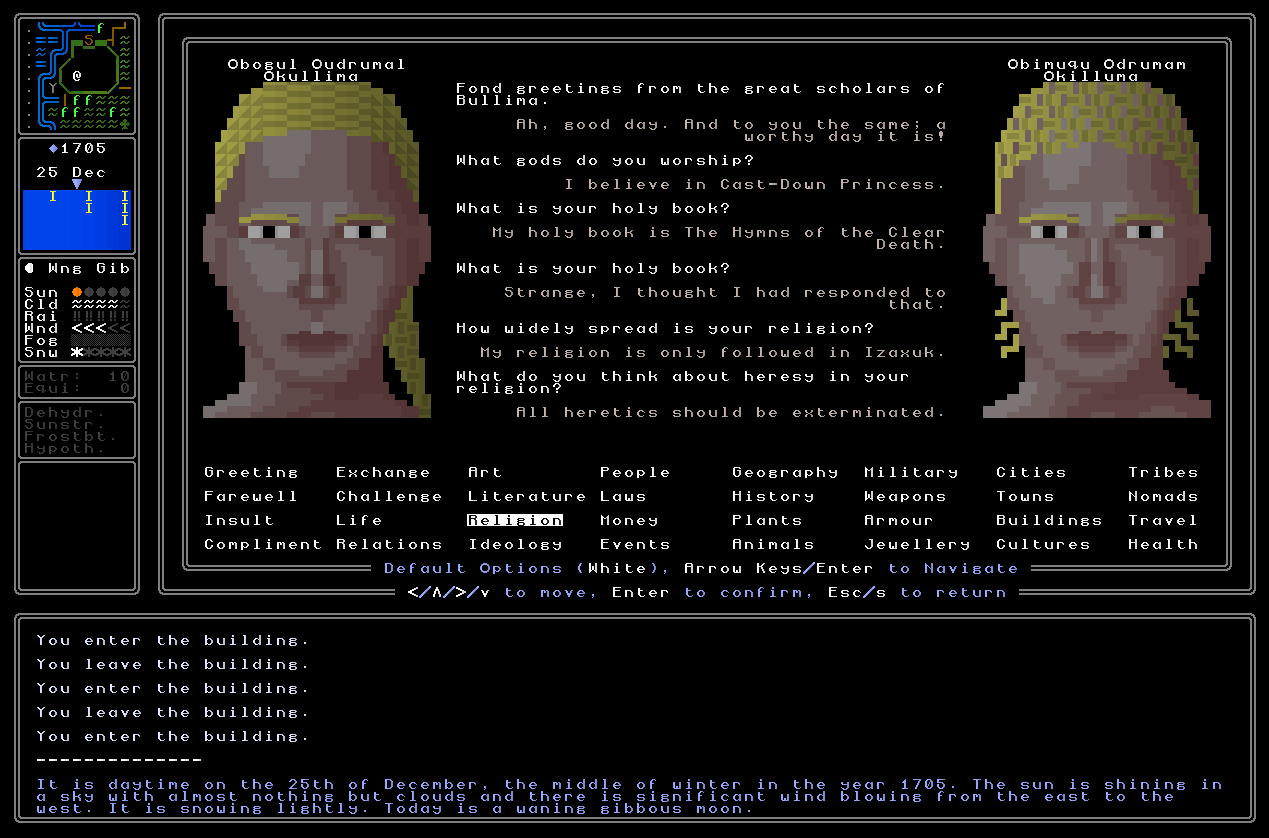
By the standards of my coding competence when I first designed and implemented it, I was very happy with it – and, indeed, by the standards of conversation complexity in 99% of other roguelikes, I was very happy with it. However, as time goes by, it has begun to resemble some of the graphics I’ve been reworking this year and last year. Perfectly reasonable when first implemented and perfectly serviceable for a few years, but just not quite up to the level of generated detail and complexity and interest that the rest of the world offers. I will also fully admit that I have been pushed further a little here in part due to a re-watch of Game of Thrones (seasons 1-6, that is, i.e. the only seasons which exist) and my slow but steady progress through the Malazan Book of the Fallen series. How can I get my characters to speak a bit more organically? I want to get characters to regularly pass comments about the world and to also have more distinct personality, with different people being genuinely different in what they have to say, and how they say it, when you interact with them. Ultimately the question is: how can I get them to flesh out their answers, to make japes and jibes, to pass comments, to make snarky or derisive insults, to sometimes say a lot and sometimes say only a little, to sometimes give objective fact and sometimes offer only rumour and bias, and basically just to seem like living parts of a world with a vast and rich cultures, histories, religions, politics…?
How? Well, I’m glad you asked.
First, I’m making some major changes to the categories of conversation topics by removing a few, compressing quite a few together, and implementing a range of new major topic categories that will more fully reflect what’s in the game and what the player might need to know about. This will enable the player to ask a far greater volume of interesting and useful things of people they encounter, it’ll boost the range of conversations possible, and it should integrate nicely with all the various aspects of riddle-solving currently being developed. It also takes some categories which were pretty empty, and either does away with them altogether, or combines their content into others. This, then, brings us to the next change:
Second, I’m massively expanding the number of things you can ask someone within each topic set, and the number of questions with square brackets we have, e.g. “What do you think of [book]?” or “What do you know about [river]?”, and so on, where you can insert any relevant thing you’ve so far discovered. All the new categories and the modified existing categories now have around twice as many options as was the case in 0.10.2 (and earlier) and many of these options will allow you to get new sources of information that weren’t previously available. In turn, as I say, there are now more than twice as many questions which enable you to customize the question based on a specific place, a specific artist, a specific item, a specific event, a specific religious building, or whatever it might be. You’ll be able to fill in these questions via lists, but also via selecting something on the local map to ask about (e.g. “What do you think about this religious altar?” while pointing at an altar) or the world map (e.g. “What do you think of this area on my map, known as the Expanse of the Blue Wolf?”). The more questions we can have you asking about the more specific things in the game world, the deeper this system should become.
Third, I’ll be adding a huge amount of new detail to replies, allowing replies to change based on what you’re wearing, previous questions you’ve asked, things the NPC knows about you, where in the game world you are (building, nation, settlement, region, whatever), and many many other factors. Essentially I’m going to be rewriting the majority of the conversation system to add a lot more depth and detail here, and this includes giving characters the ability to lie, offer rumours, make jokes or state insults, and things of this sort. All of these changes should make the exchanges a lot more organic and human.
Fourth, I’ll be implementing the possibility of direct replies, and the possibility of NPCs to ask you things rather than making questions and responses. They might just ask you a simple yes/no question, in which case you’ll be given those options as well as the ability to ignore the question and ask them another question instead (which they might or might not appreciate) – they’ll also have the ability to ask you the sorts of questions you ask them, e.g. where you’re from, who you worship, your history, your objectives, and things of this sort, and you’ll of course have the option to lie or be truthful, or something in the middle, or whatever it might be. Again, the conversations right now are very much like a Q&A where you’re just interrogating the other character, and this is the feel that I really want to move us away from.
Now, you’ll notice the change in tense between #2 and #3 here, from “I’m” to “I’ll be”, and so I’ll focus on the first two, as those are the parts I’ve got done so far. Firstly, here’s the old set of conversation topics…
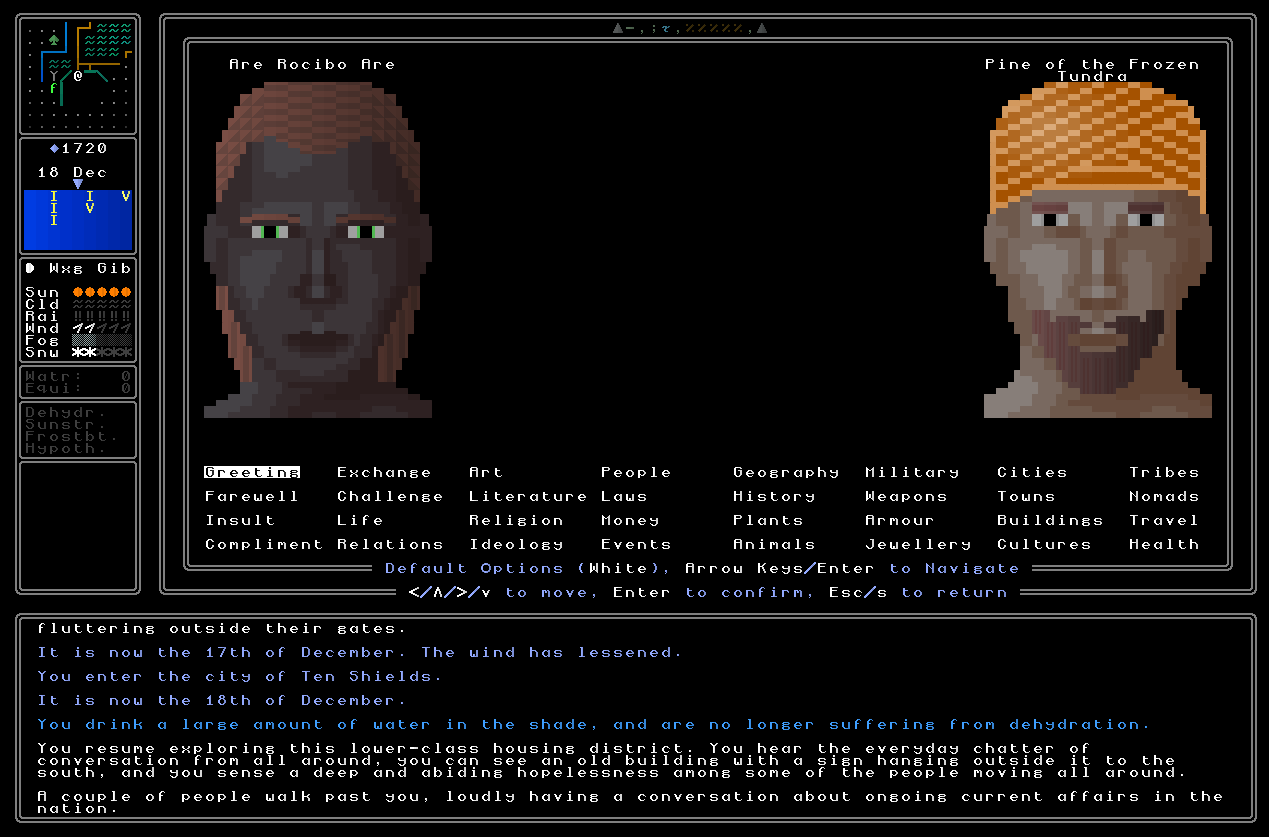
…and here’s the new set:
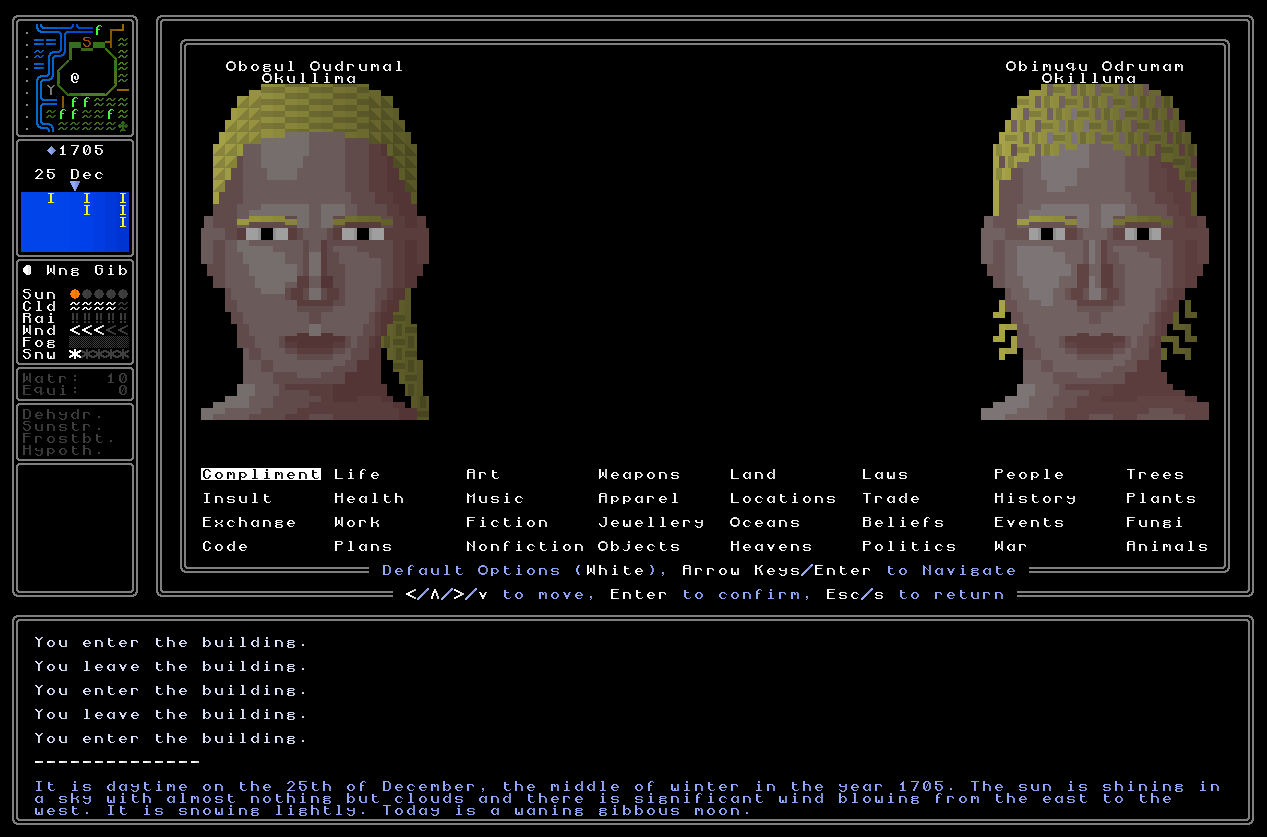
Of note are various changes. The first, for instance, is the “code” option, which will allow you to create a totally custom sentence of the sort “The red eagle has left the nest” or “The dying soldier watches over the fort”, or whatever – as a way to convey, via seemingly innocent sentences, something important to a particular person. Of course, if you just say these sentences to random people, they’ll give suitable responses (e.g. “Has it? That’s… nice?” or “I’m not really sure what you mean”, or whatever). I think this’ll be a lot of fun and another way to allow “codes” – broadly defined, here – to be used and inputted into the game. Another change is that art and creative work has been split into “art”, “music”, “fiction” and “nonfiction” and each of these categories will have a lot more detail now, especially as these things come to fully be present within the world! Nature has also bee split into four categories – “trees”, “plants”, “fungi” and “animals” – some of which generate now, and some of which will very very soon. The final two columns, meanwhile, have some similarities to those in the previous set, but have also been modified. This set of options is way more useful for where the game is going, but this changing set of sets (as it were) is only the start. We also have four new categories, “land” (areas, terrains, territories), “locations” (buildings, settlements, ruins), “oceans” (ships, sailors, pirates, sea monsters??) and “heavens” (stars, constellations, weather patterns). There are also a bunch of other additions / changes there as well, but these are some of the main ones.
In turn, the second change here is massively expanding the number of possible questions. We’ll get onto replies in a later entry (because that’s a big one!) but for now, here are a few examples of some of the new and expanded question sets:
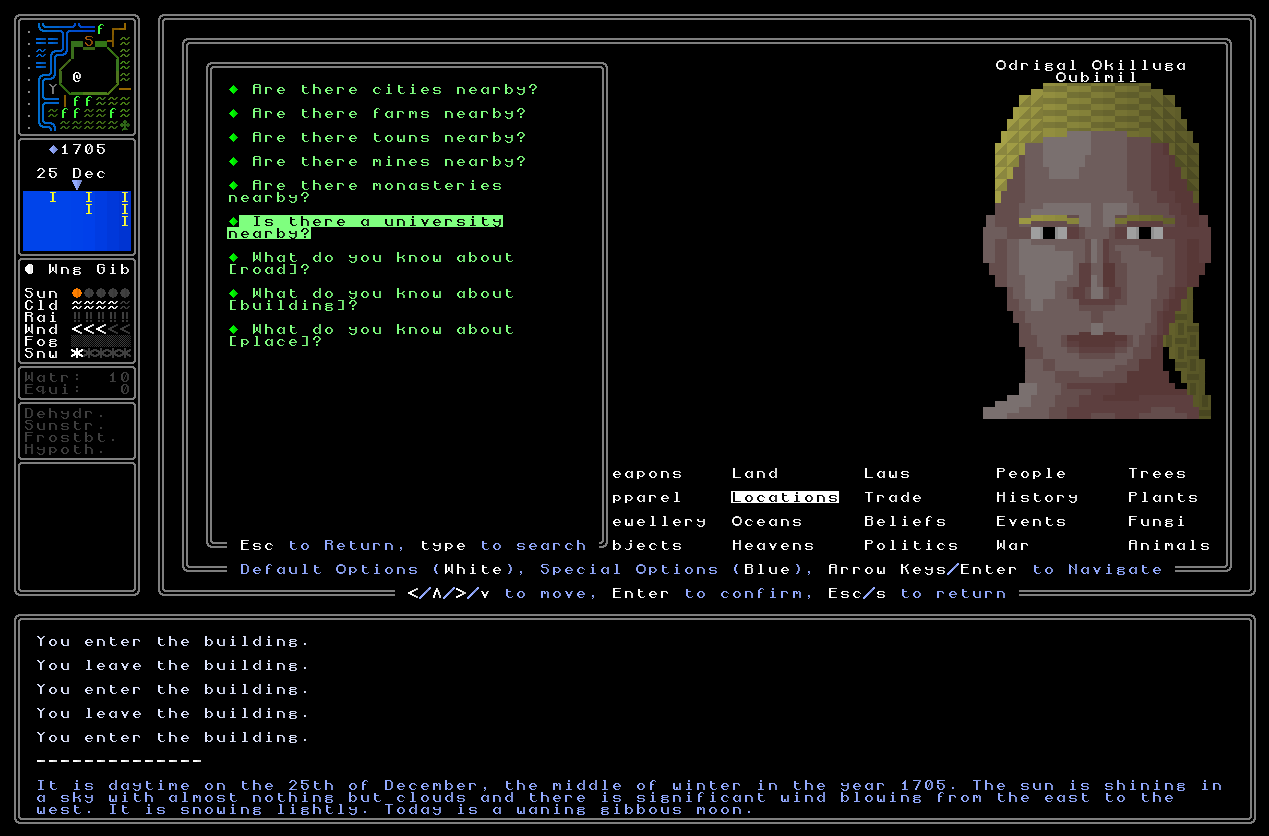
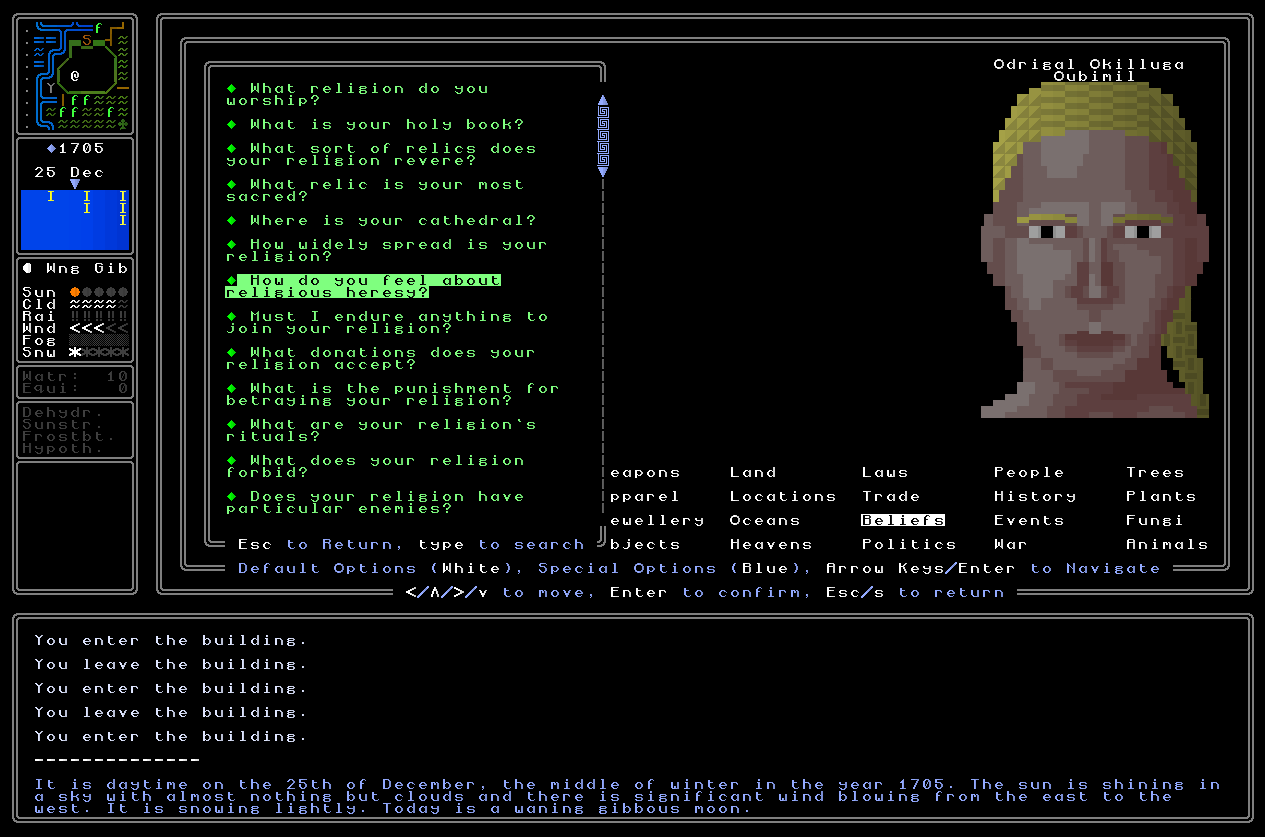
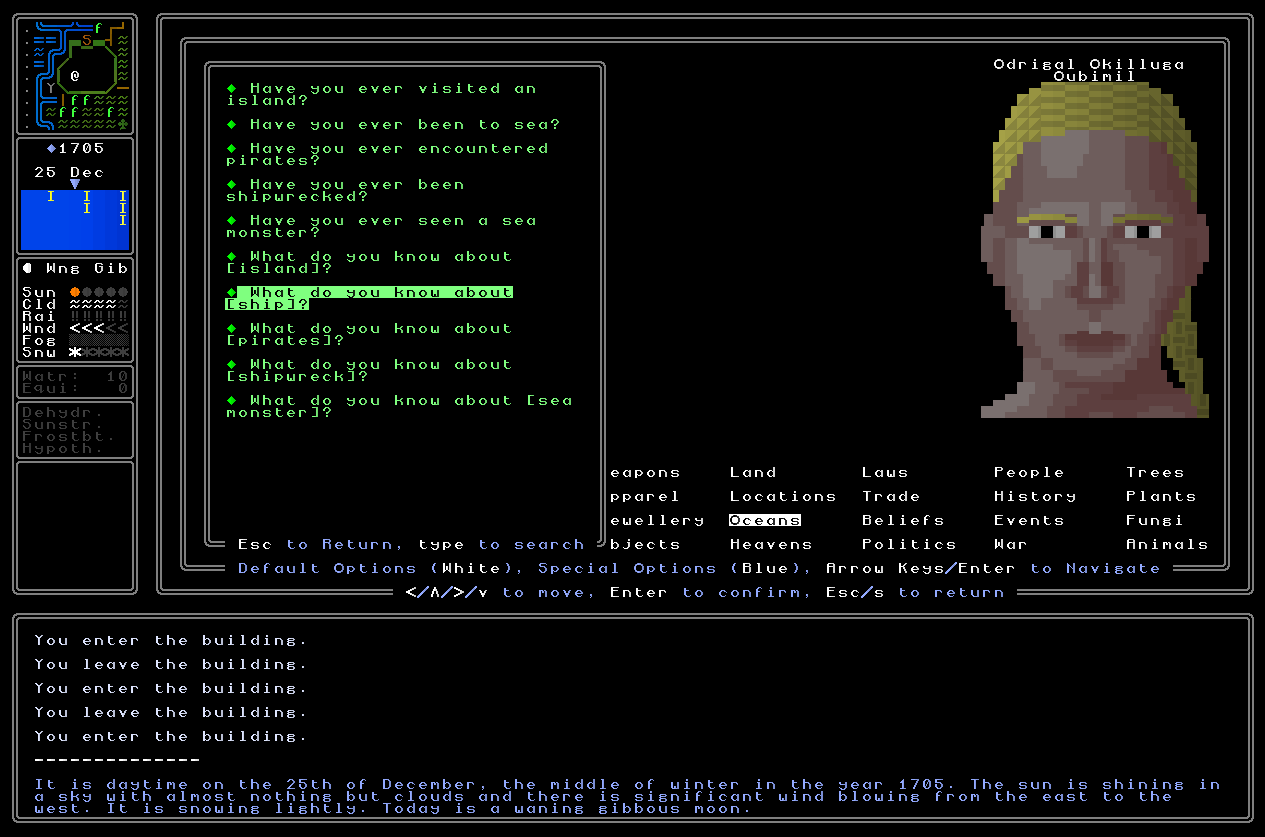
(And so on)
Now, this is just the start of the rework and I anticipate continuing to update all of you on this for the coming months, as let’s just say this new model is going to require me to write many, many thousands of sentences – which of course in turn have procedural elements, either to a greater or lesser extent, depending on everything else going into them – and that’s a job which can only be done bit by bit. But, we have started, and there will be more coming soon on this!
Hands
For many years now all NPCs (and the player) have had generated faces. In probably the next blog post I’ll be talking a bit about how I’ve recently updated, improved and expanded the pool of potential face generations, and this has indeed brought a lot of valuable extra detail, but I have now also decided to add another body part – hands. When you’re looking at someone (or looking at yourself) you can now press the space bar to cycle between that person’s face and their two hands. Interestingly the hands took an immense amount of time to get right, both in terms of the size and shape, the structure, the use of the game’s ANSI characters, and also making sure that there was enough space and possibility for meaningful variation in how the hands actually look, e.g. scars, tattoos, scarification, missing fingers, and the like. After a surprisingly long development process, however, I’m really happy with what came out in the end! Here I am, for example, having a look at my face…

…and then I press the space bar, and can look at my hand, instead:
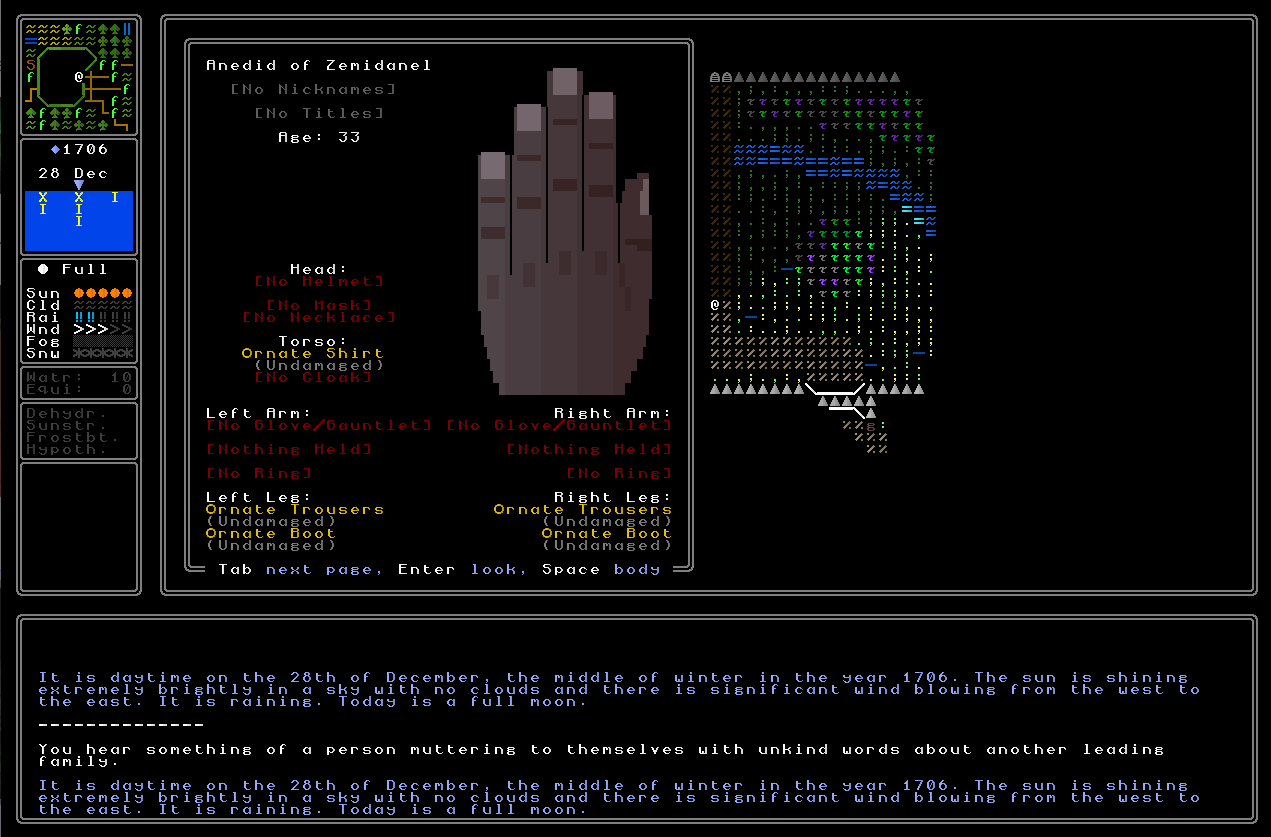
And obviously press again to see the other hand). And, an example with a much paler skin tone:
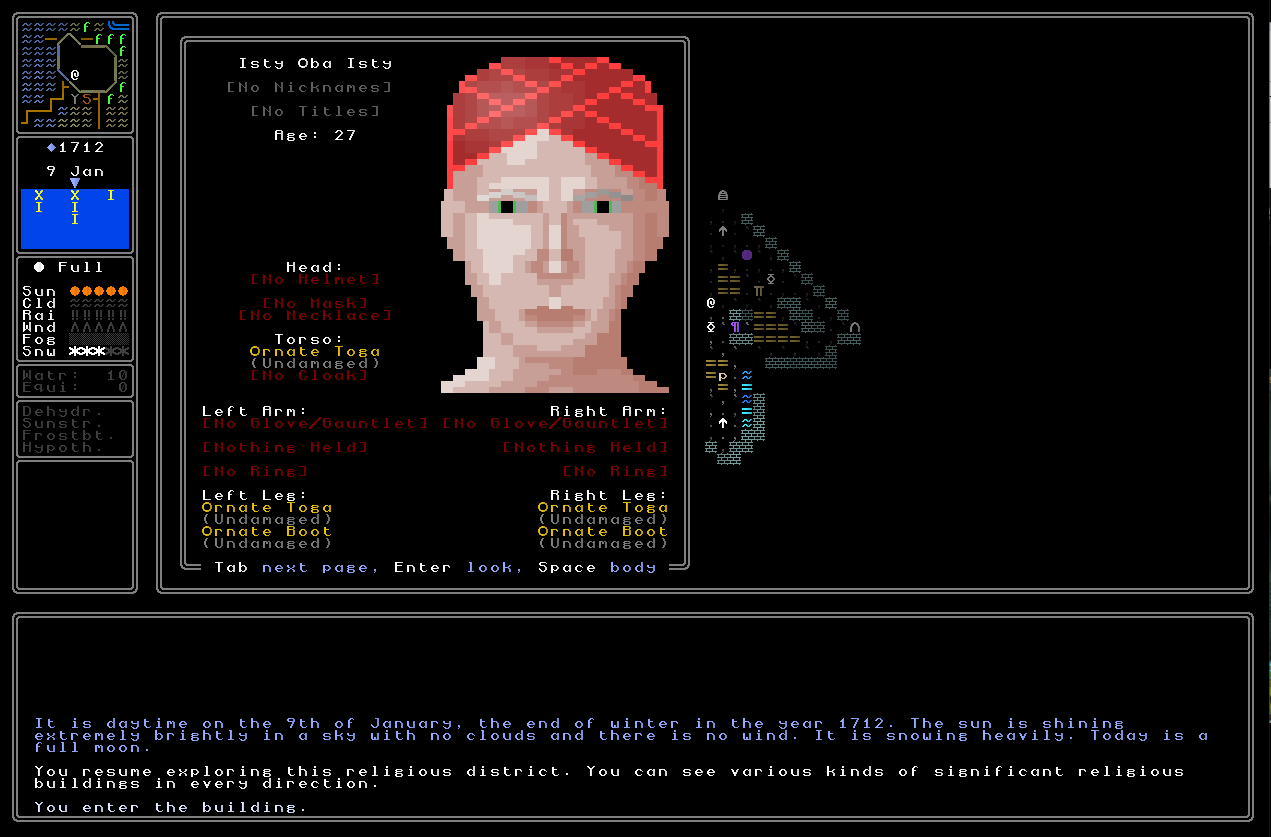
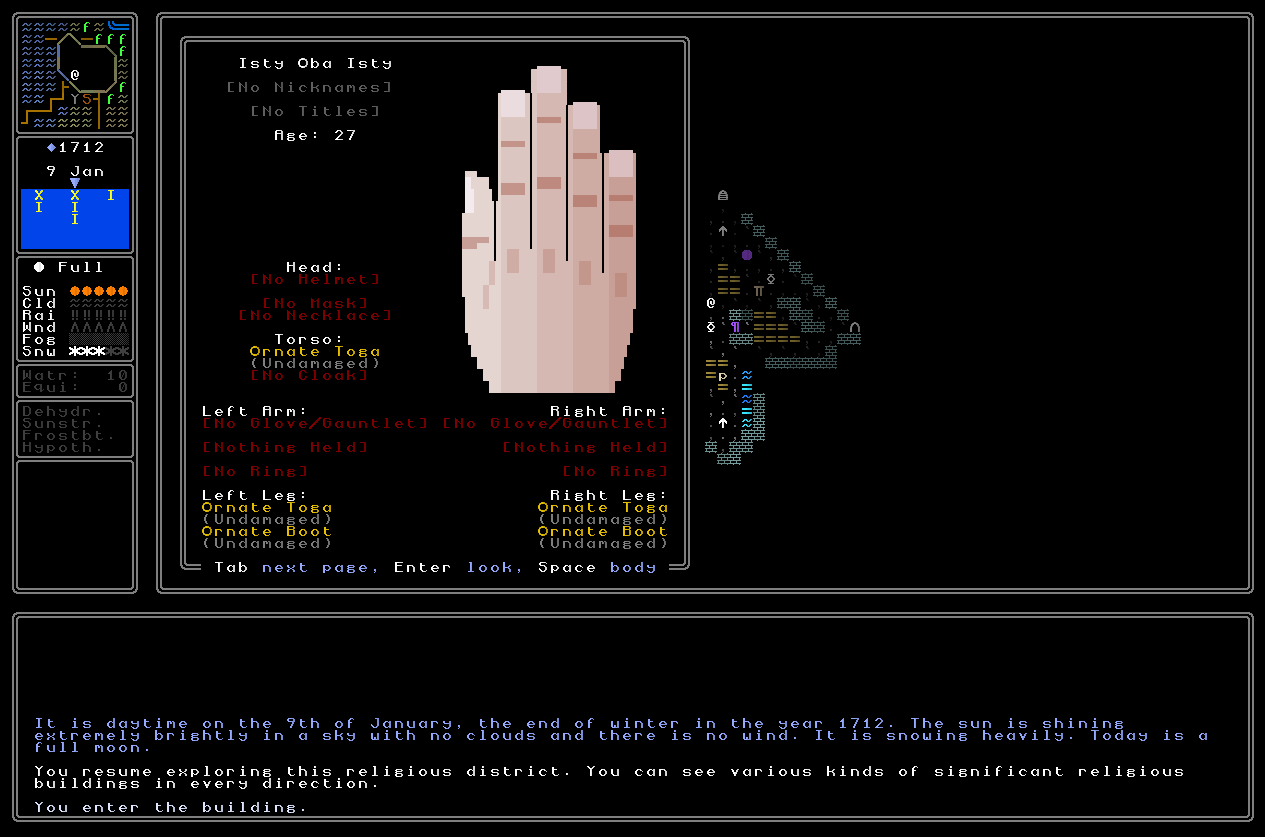
Now, these hands are looking a bit pristine, I think! Time to fix that. So, firstly, for people with scarification on their faces or facial tattoos, these aesthetic / cultural choice also apply on their hands, e.g.:
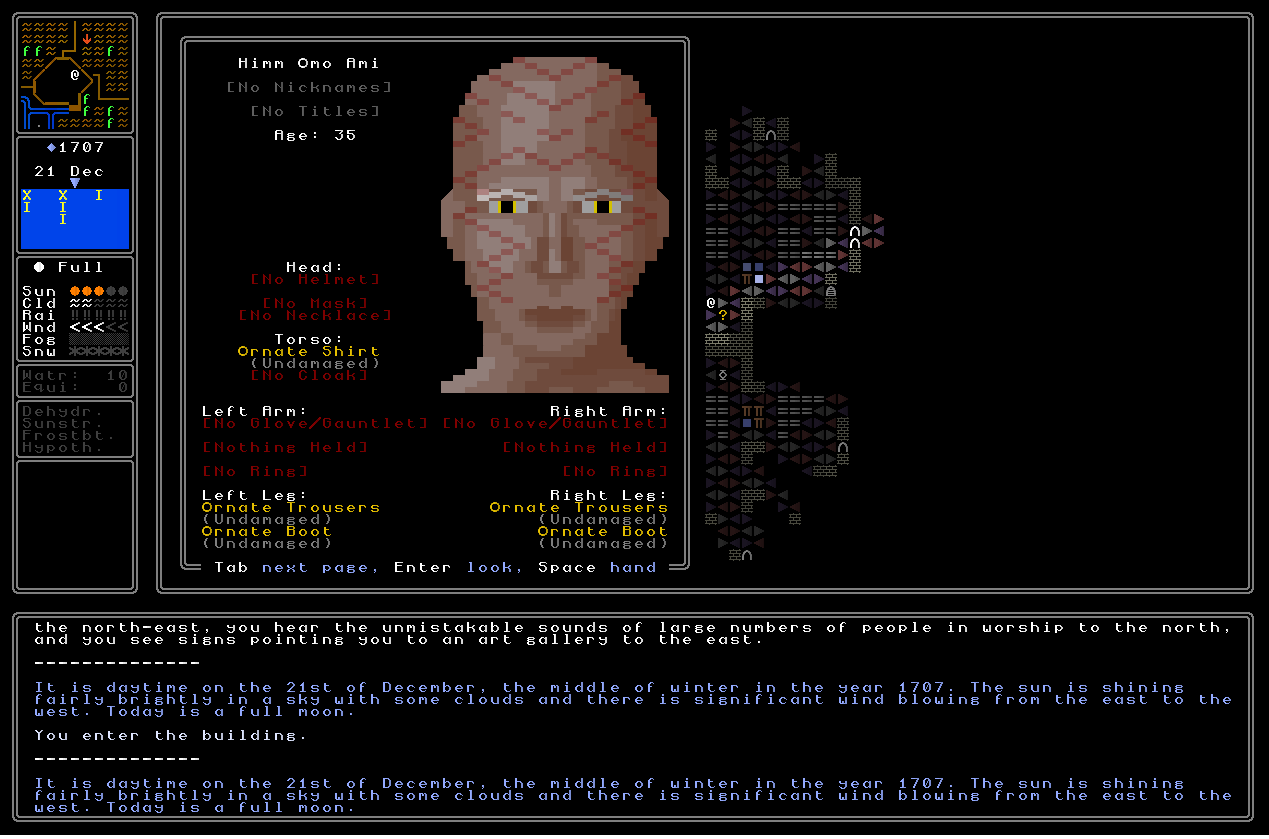
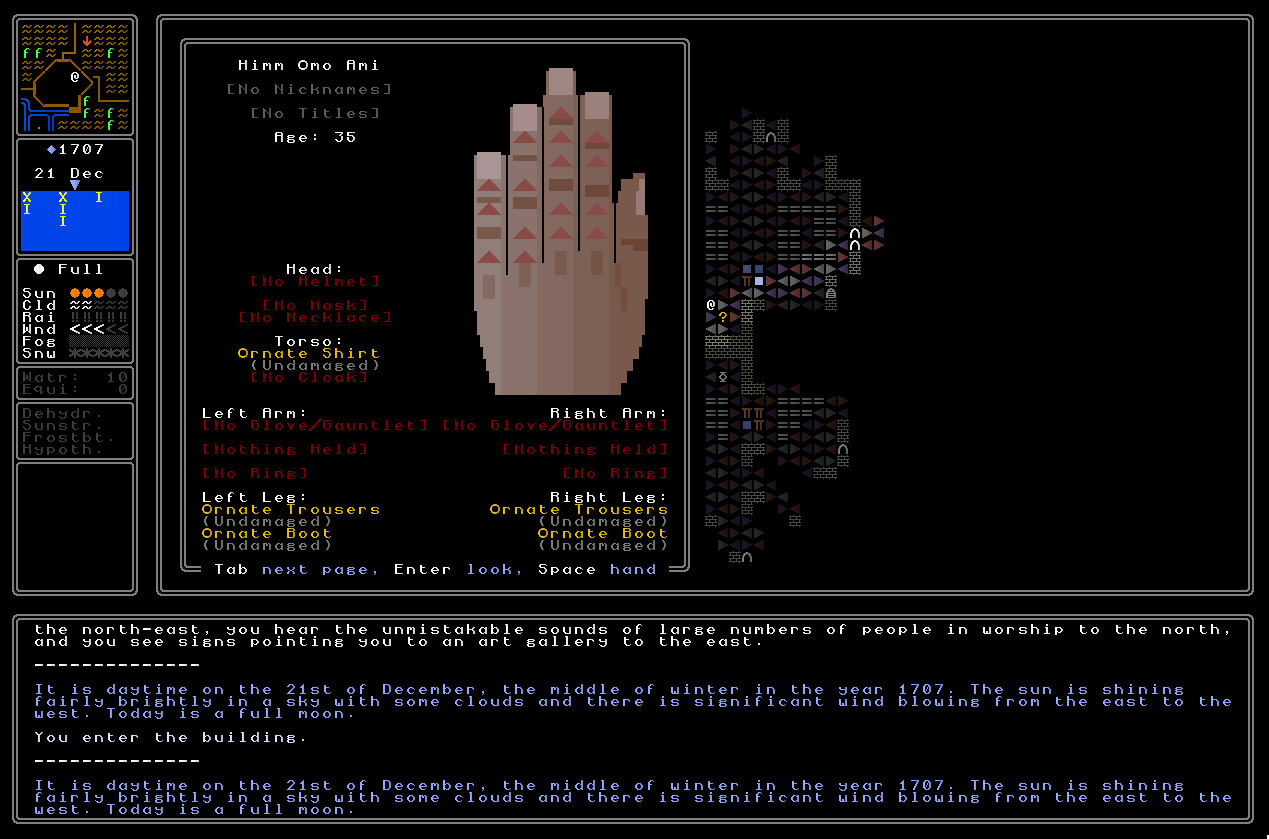
Or:
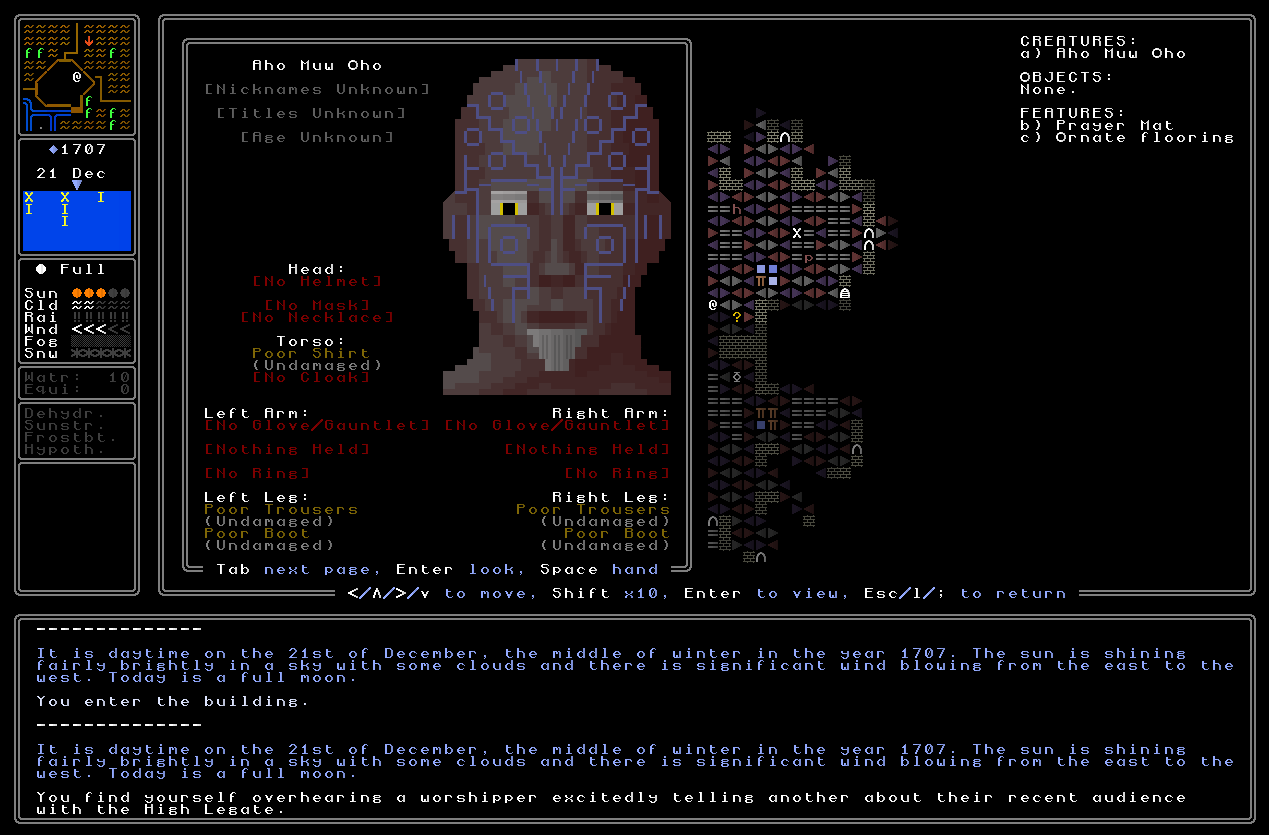
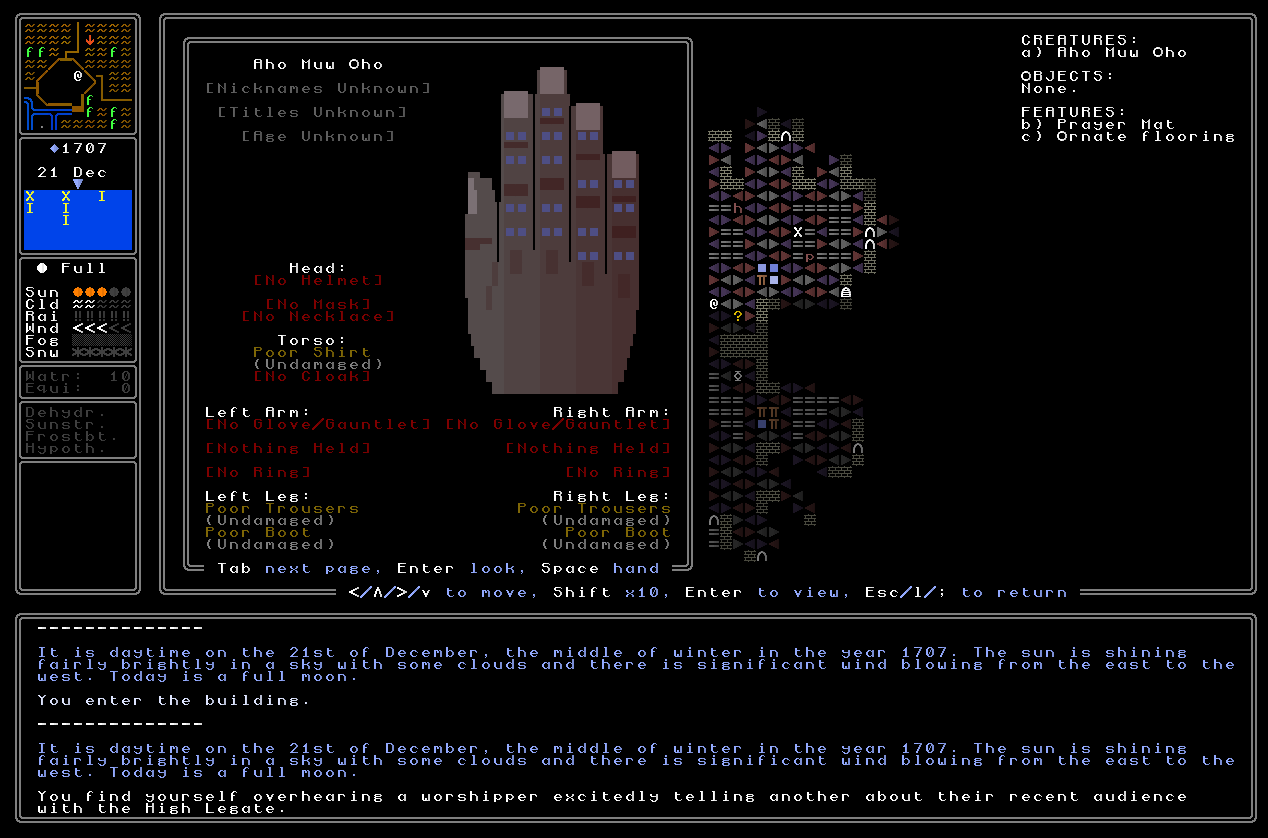
(There are 20 different hand patterns, and 10 are randomly given to the scarification civ in each world at world generation, 10 are given to the facial tattoo civ at world gen, and then each person within those civs picks one of those ten at random when they are generated)
But you’ll notice these leave a nice gap in the middle of the back of the hand, and that gap is for religious initiations. You’ll remember from a recent entry that some religions will ask for the removal of a little finger, or scarification of a randomly-chosen hand, or tattooing of a randomly-chosen hand, in something that accurately depicts their religion. These were a ton of fun to implement, and there are now well over fifty different symbols that might appear on hands! Not all will ever generate within a given world, of course – generally no more than four or five of the entire set. Much like the demonic staffs above, a nice thing here is that the special words in some gods that trigger special symbols here are not the same as the ones that trigger special staff types, so sometimes a god name might trigger both (e.g. “The Winged Defiler of the Blaze” will trigger “Winged” for a different staff type and “Blaze” for a unique scarification / tattoo type), and sometimes just one (e.g. “The Winged Defiler of the Pit”), and sometimes none (e.g. “The Dread Defiler of the Pit”), defaulting to the standard generators for both. Whichever happens, though, it’ll keep the variety and difference level high. Here are some cool examples, for a demonic god with some kind of fire-related word in its name, a five-sided Lovecraftian polyhedron god, a six-part pantheon of gods, a monkey god, and (this person has clearly been in the wars!) a demonic god associated with sorrow or tears:
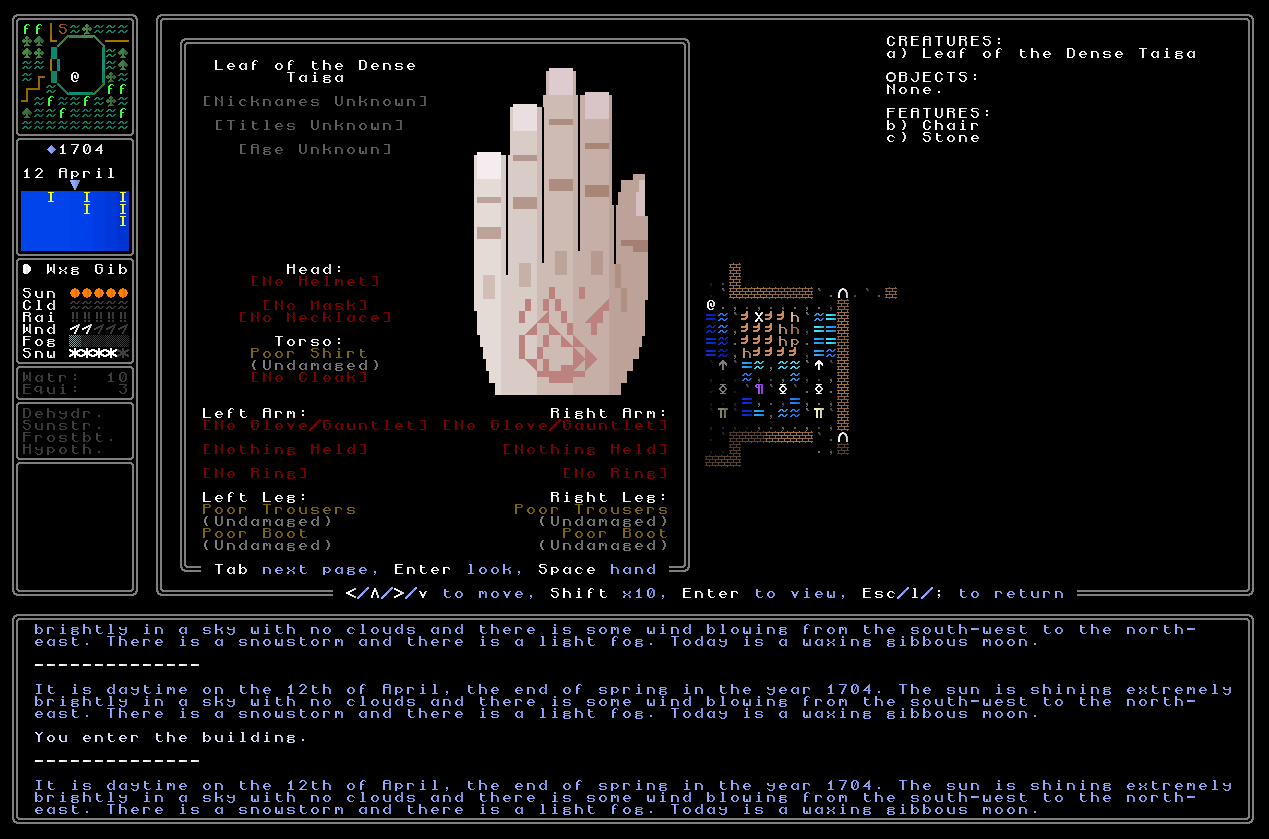
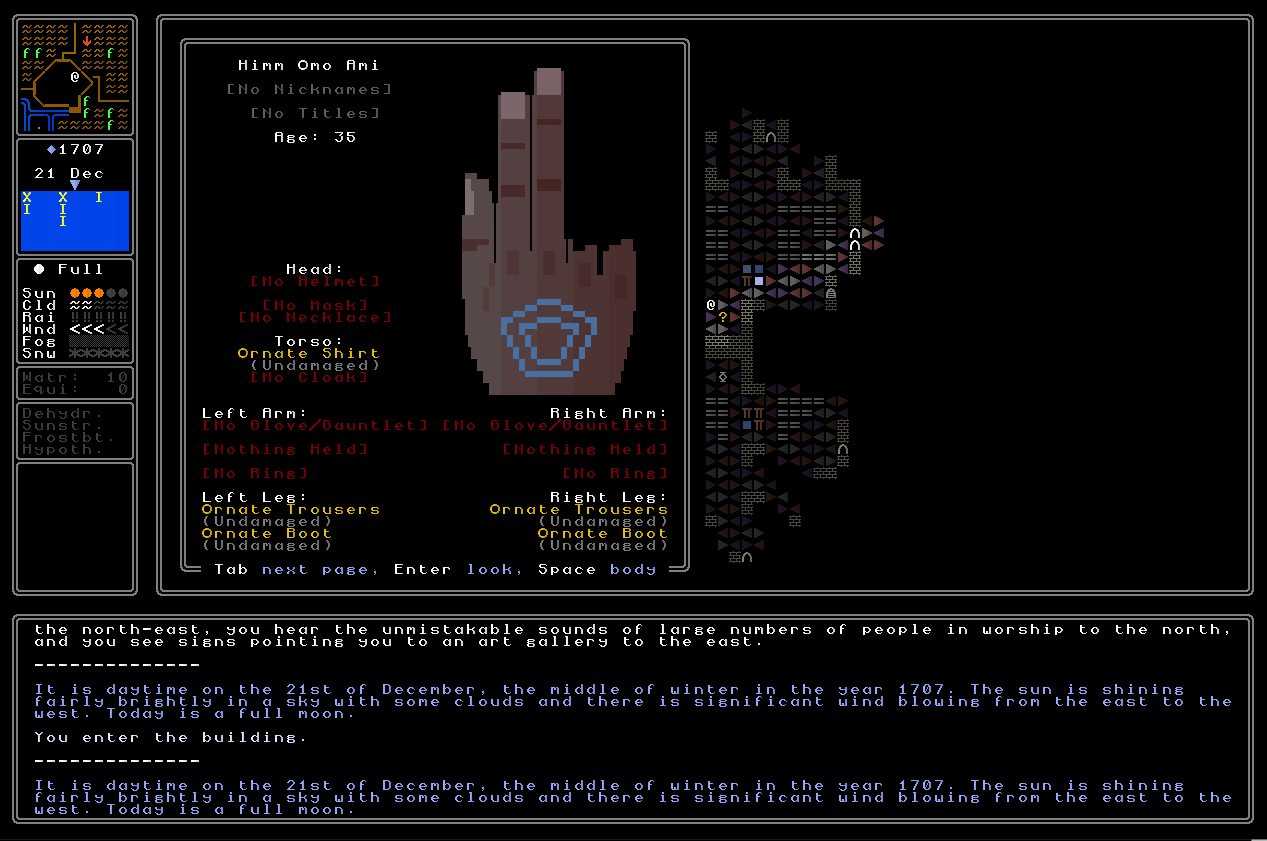
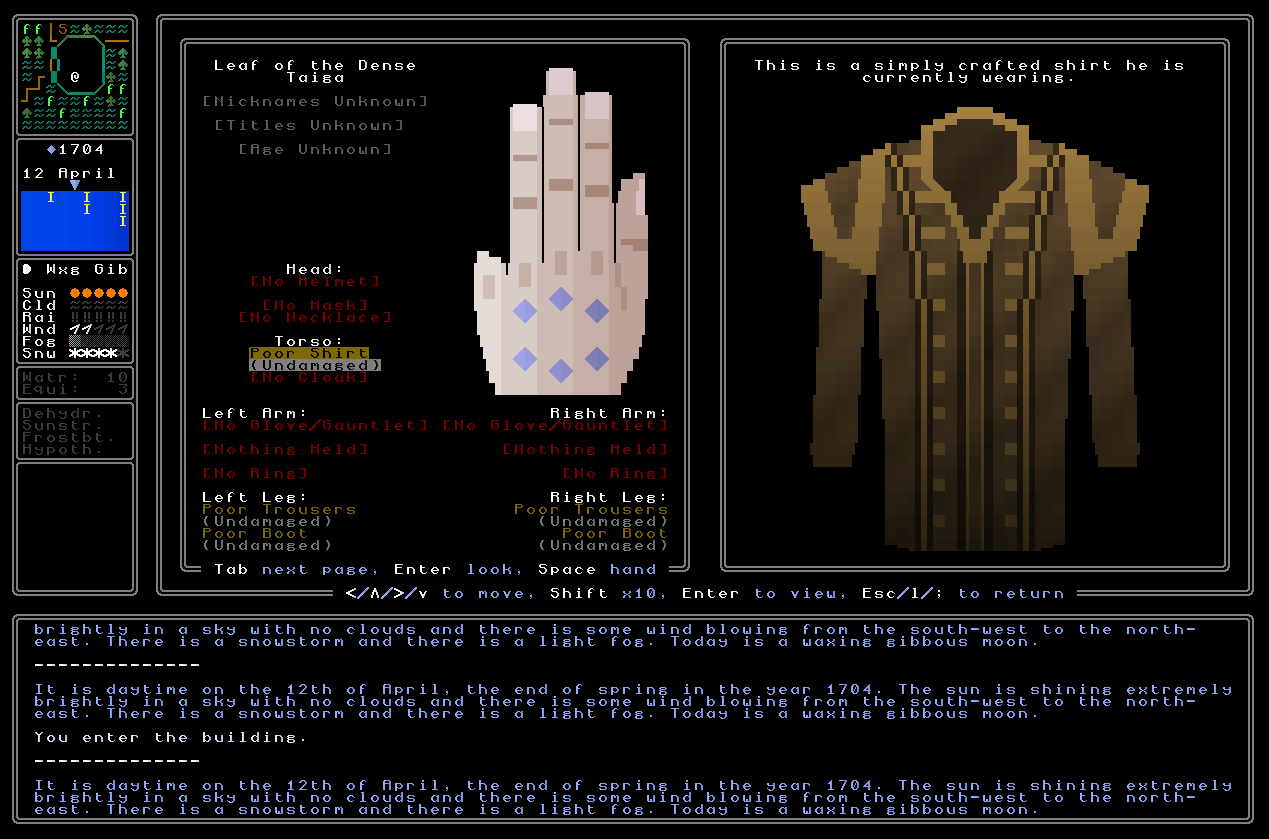
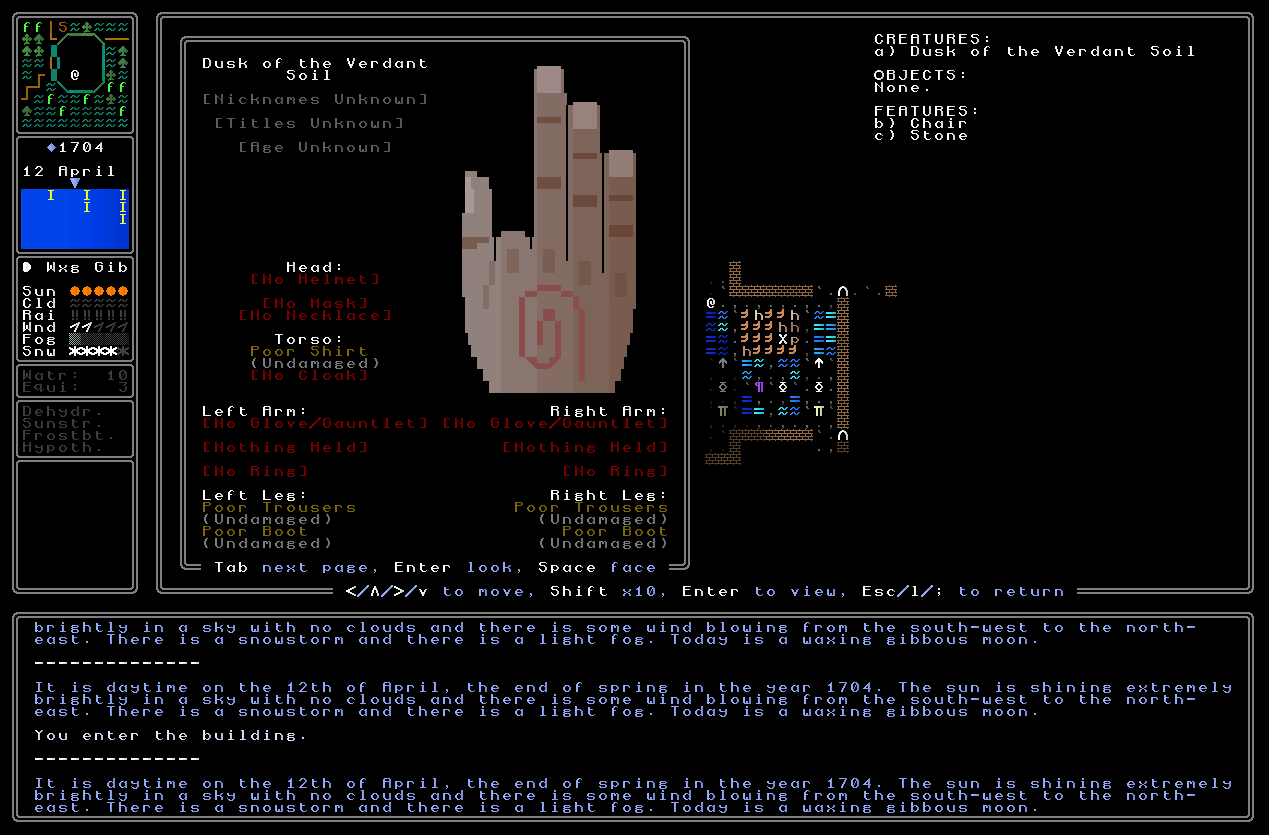
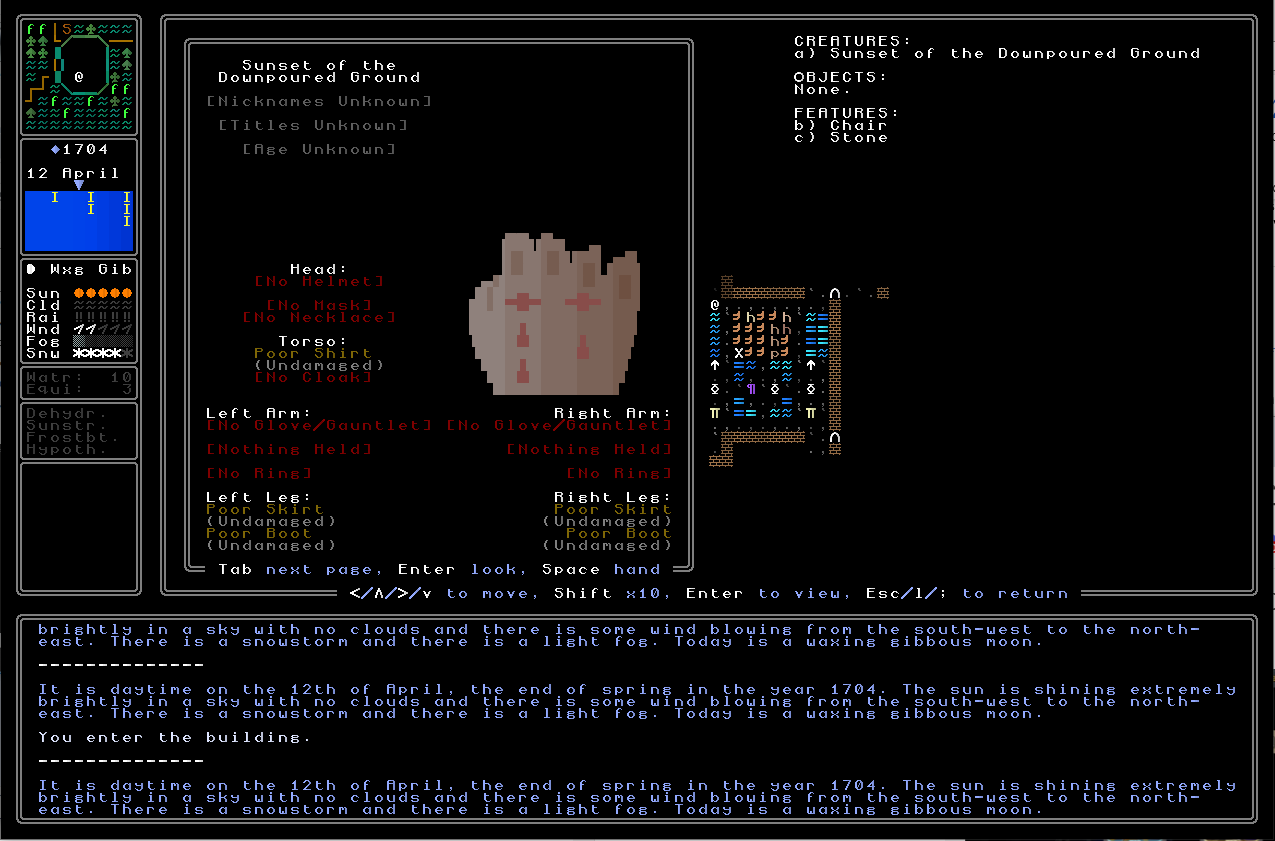
And these, of course, show the other feature – the hands will now properly show any loss of fingers or thumb! This is also reflected on the health screen, and will have relevant effects in combat, probably along the lines of losing a little finger is irrelevant, the ring finger might have a slight effect, the middle finger or index finger has a significant effect on the usability of that hand, and losing the thumb of course is going to have a serious effect. In turn if the entire hand is gone, you get this…
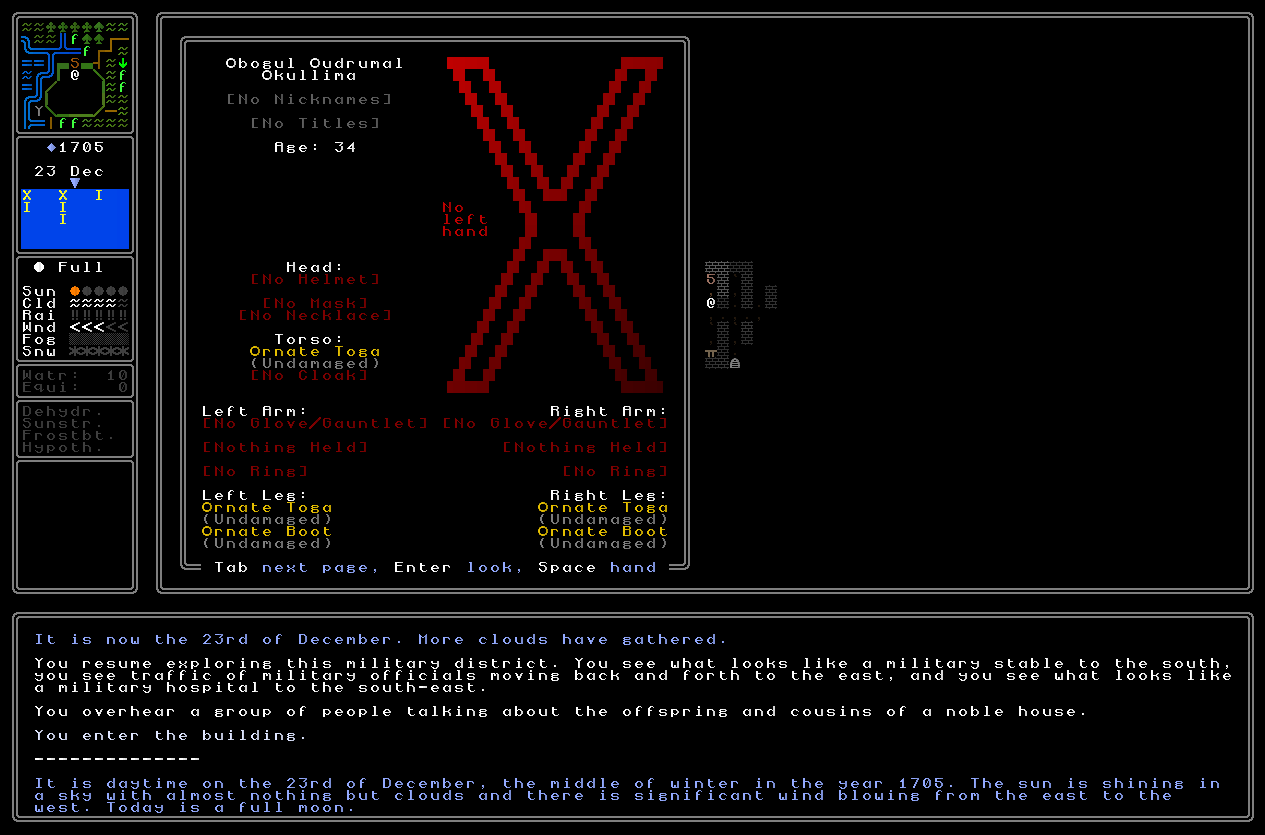
…or this…
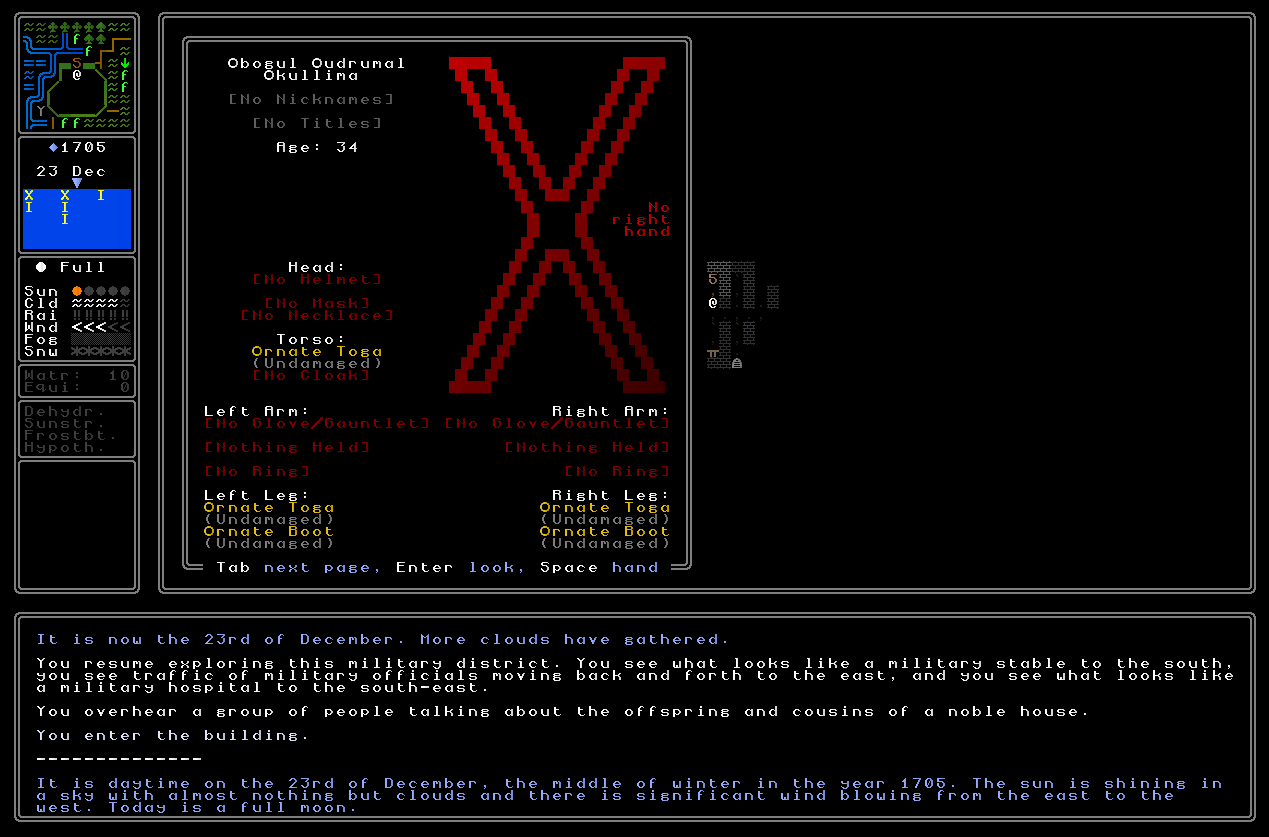
instead, while much like faces, if the hands are hidden – gloves, gauntlets, whatever – then you’ll get a question mark in their place. I’ve also added a little label here to make explicit why you can’t see the thing in question:
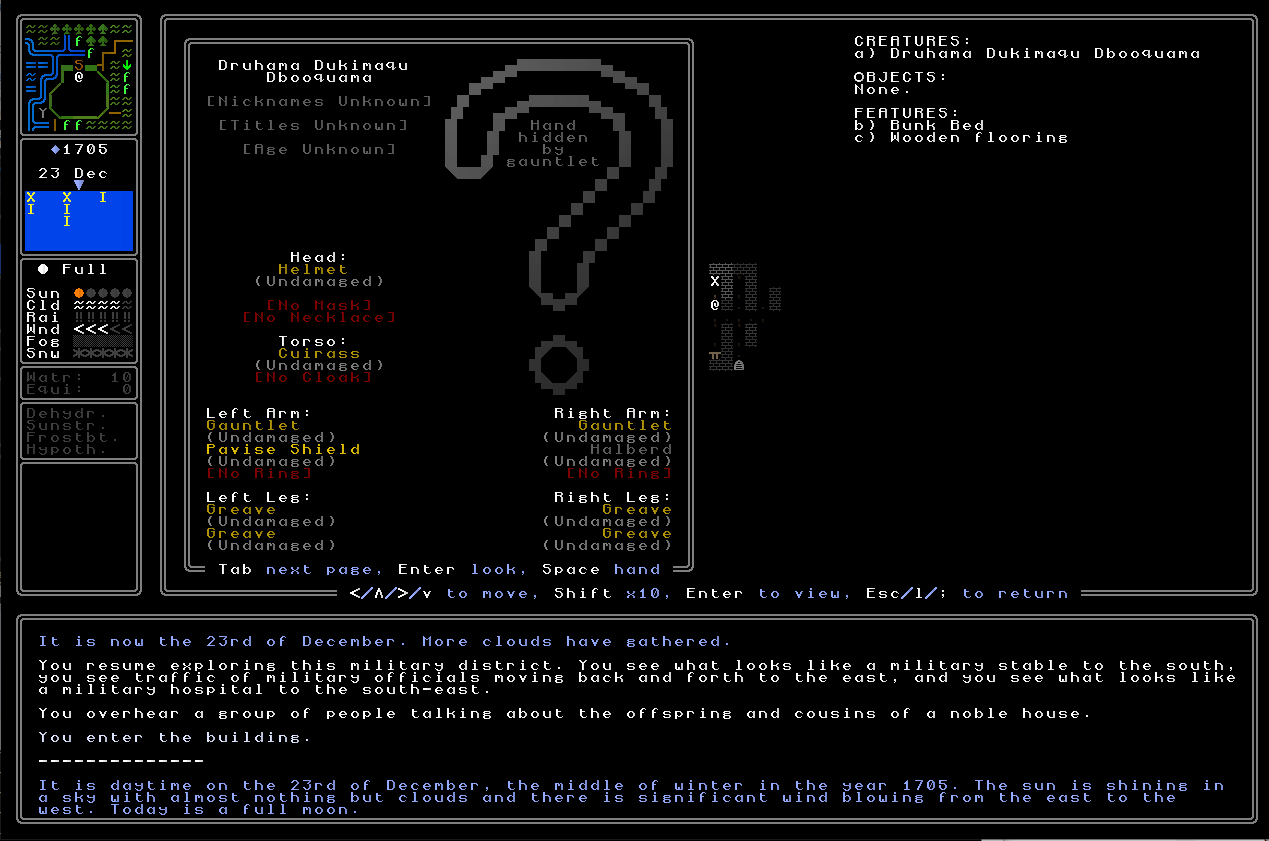
Finally, I later reasoned that actually a greater volume of interesting interactions, and a greater volume of interesting differences, will be yielded by having a few more things that make permanent changes – so now rather than the set of religion joining commitments being [little finger, scarification, tattoo] for all religions to pick from once during religion generation, it now starts at that as the full set to be distributed across religions, and then adds 2 more randomly selected from scarification or tattoo. In practice this means that around half of the religions for feudal / sedentary nations will require something permanent in order to join (while the other half do not), but these things can of course be hidden by gloves / gauntlets…
…but of course I’ll make sure that in tense situations someone might demand you take them off, so they can see your hand…
…but of course you might be able to refuse…
…while might of course bring with it different consequences (combat, or others)…
…and so on! Overall I’m super happy with this addition as it gives more to observe, more information given to the player to be compared to other sources of information, and just other cool flavour stuff as well. (And, of course, it is a contributor to combat later on… this is still being worked on in secrecy! I’ll reveal something once there’s enough solid and not just in testing to actually reveal.)
Mysteriousness
Meanwhile, I was exploring the world and in an obscure spot in the desert, north-west of a nearby oasis, well away from anything else, I found a strange building. A “sphinx-house”?
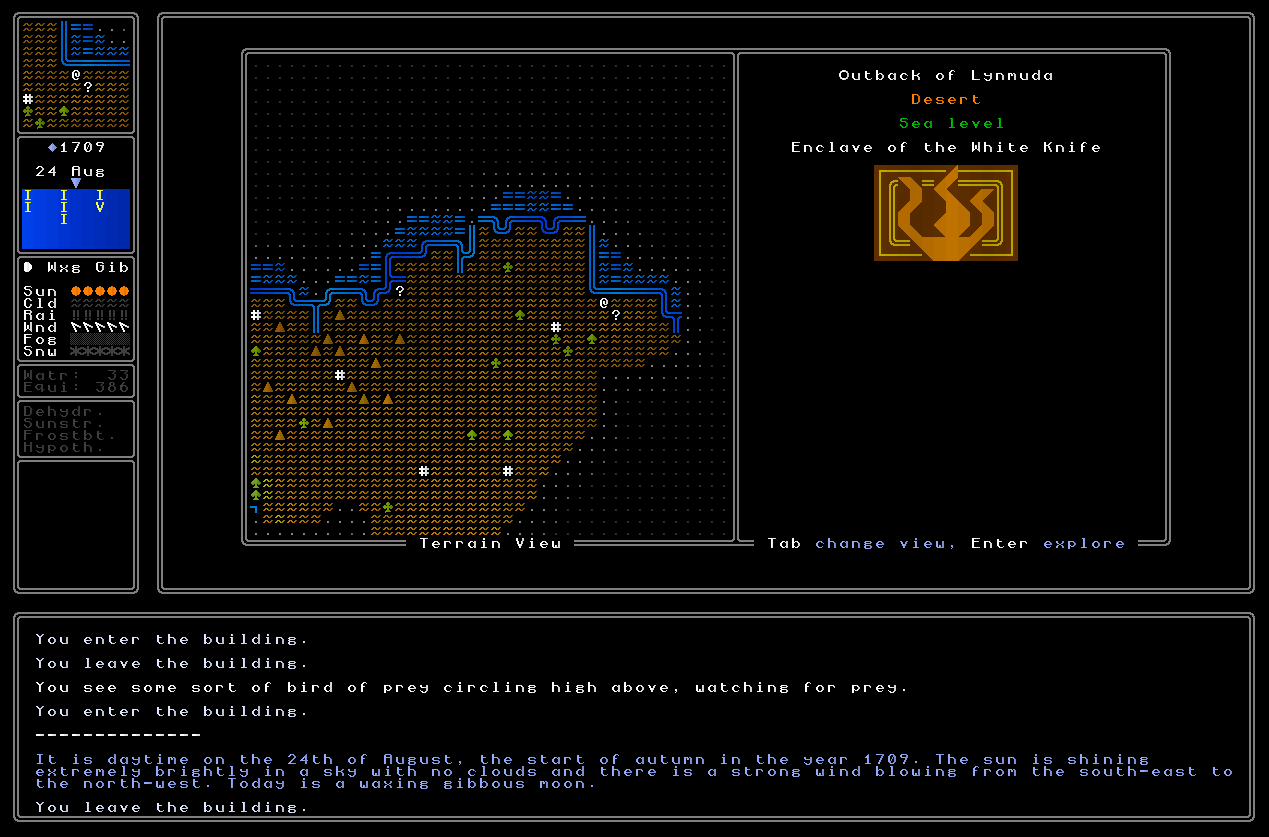
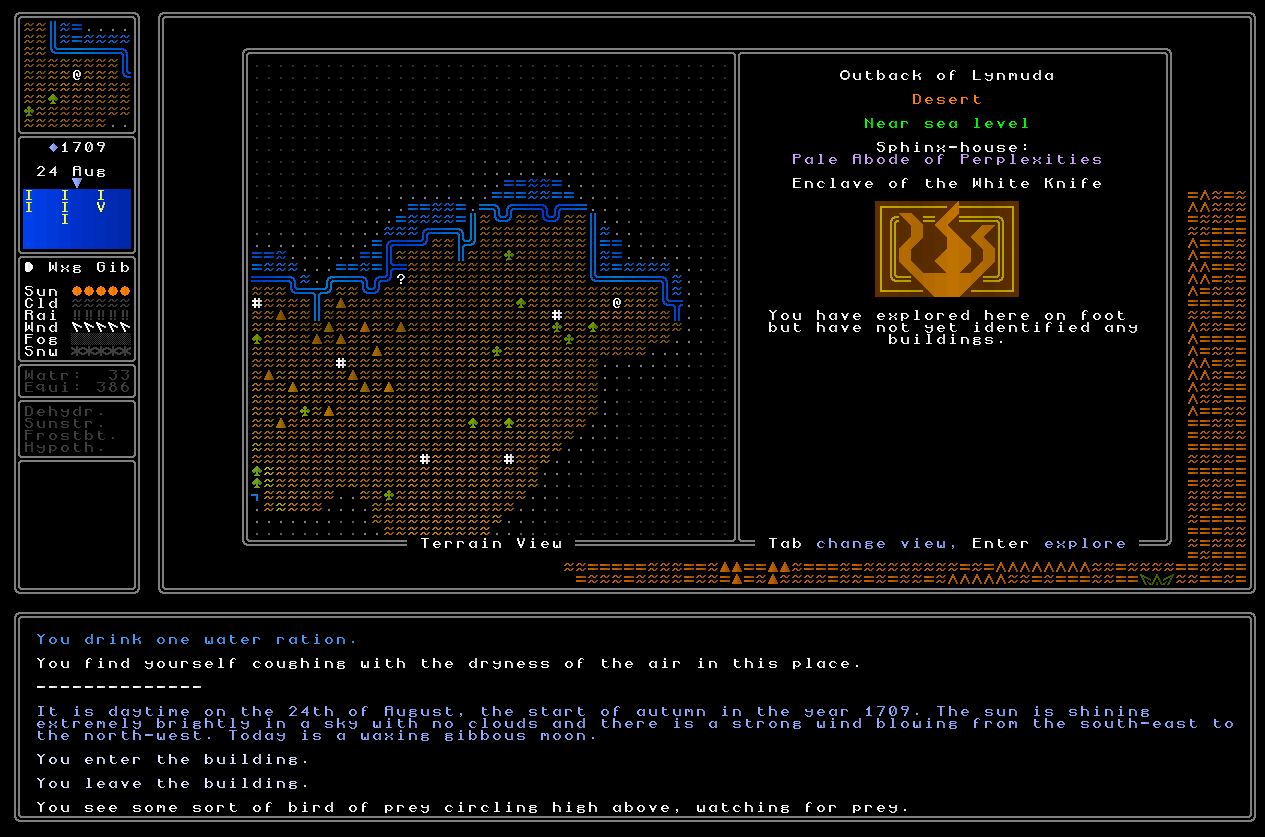
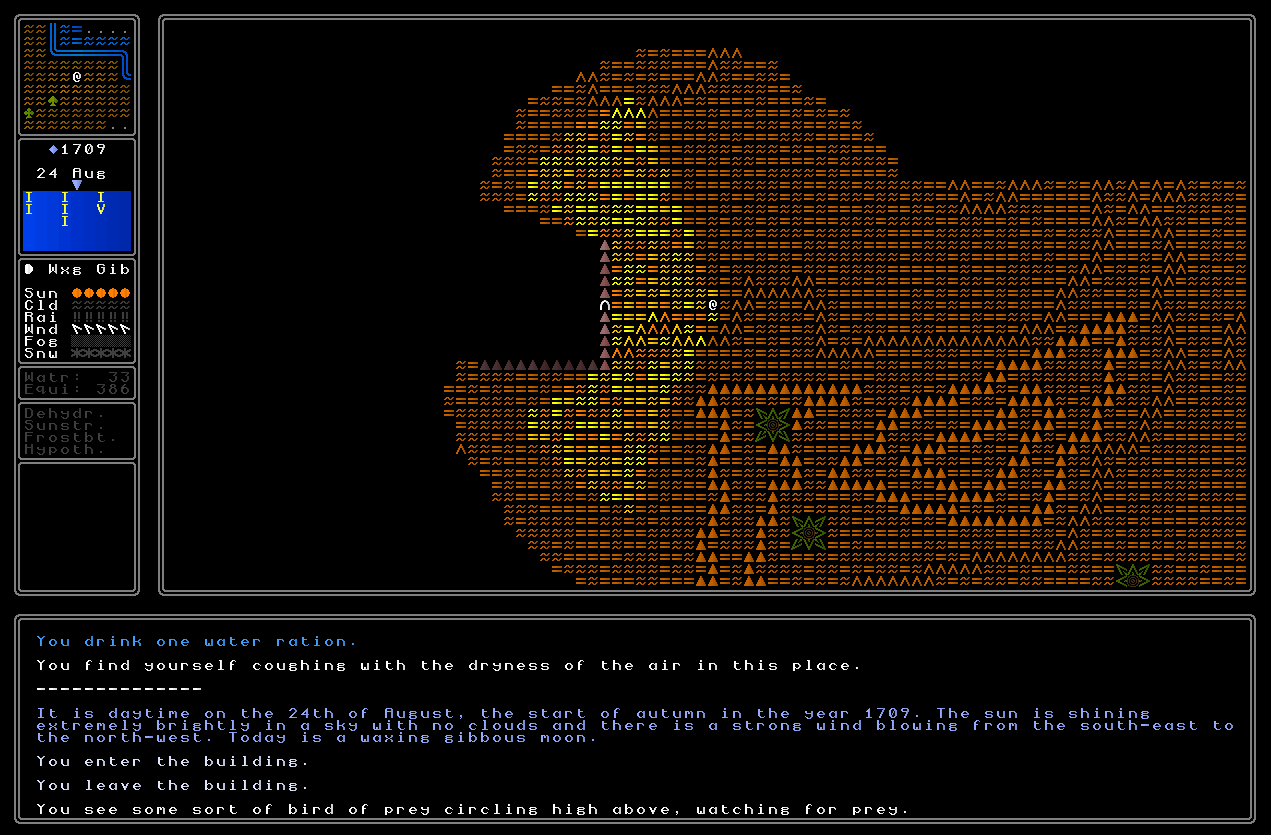
I went inside…
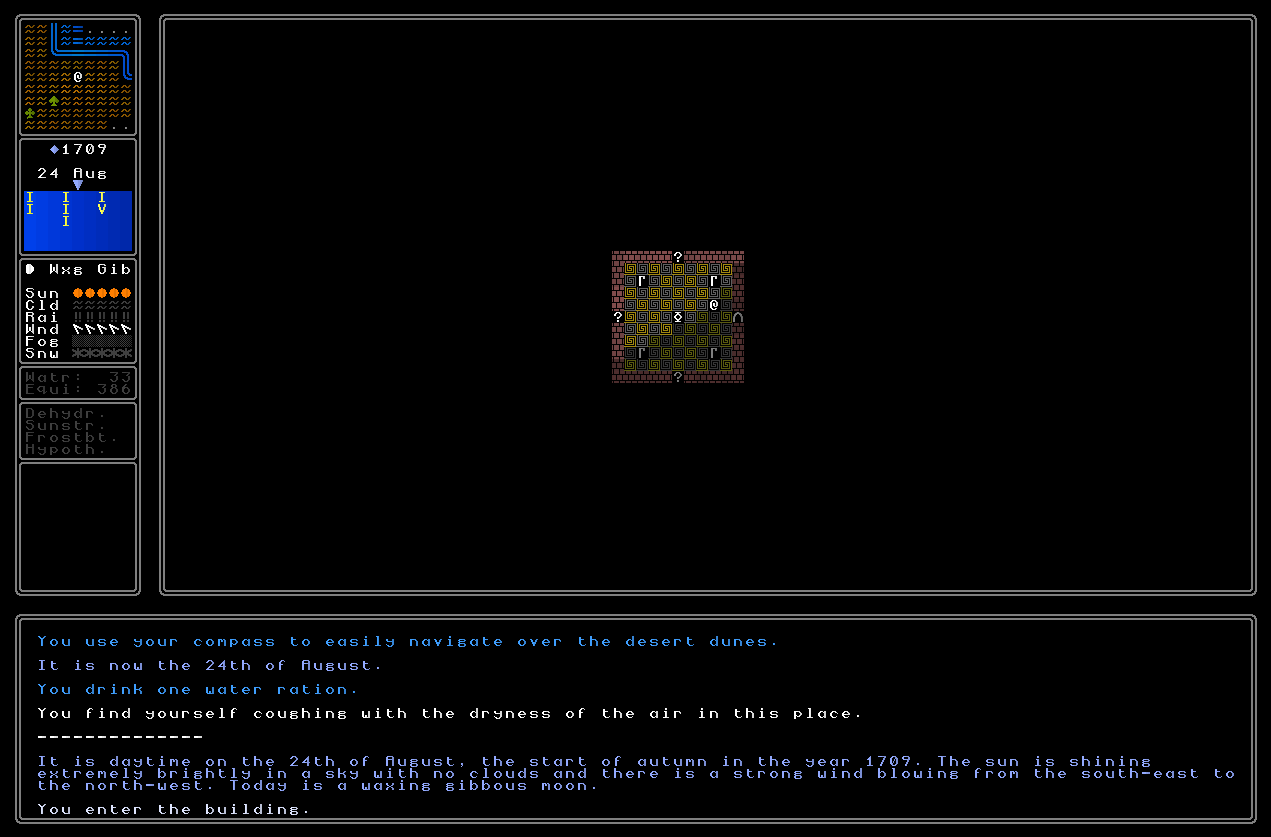
…and found some swanky flooring…
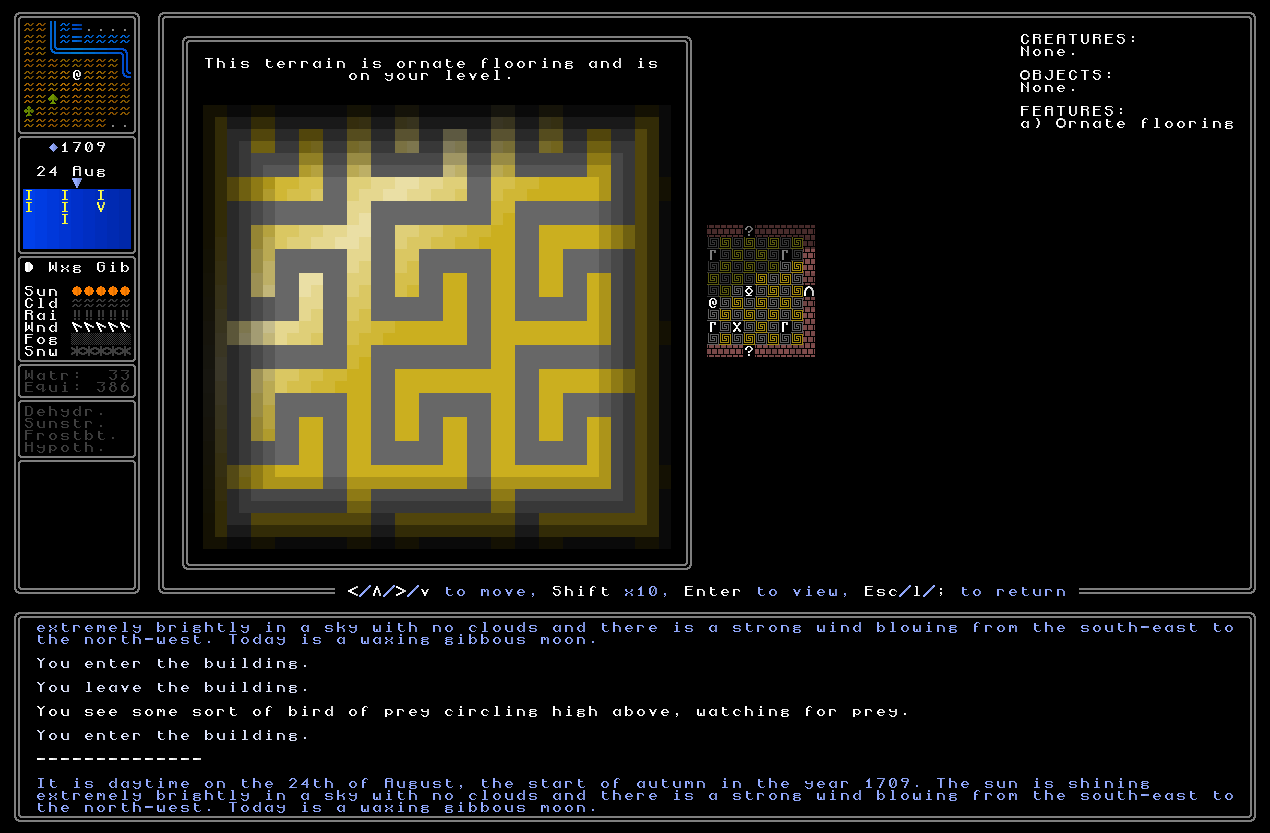
…and this strange statue…
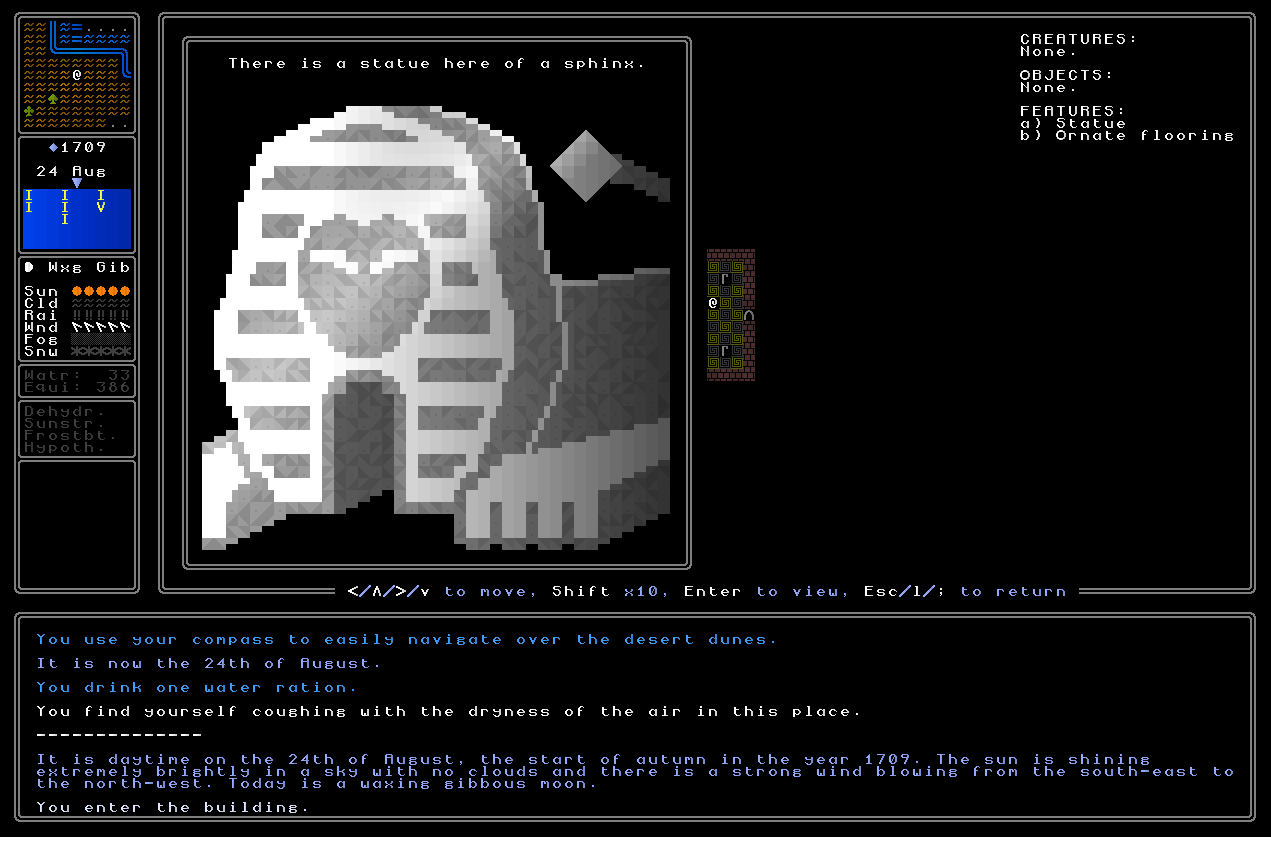
…and some really baffling riddles, which (to my untrained eye) look like they might be unique to my world! And that if, hypothetically, I could explore another world (not that such a thing is possible, of course), they’d be completely, perhaps even wildly different. Quite remarkable.
I wonder what it all means?
And how you solve them?
And what might happen if you did?
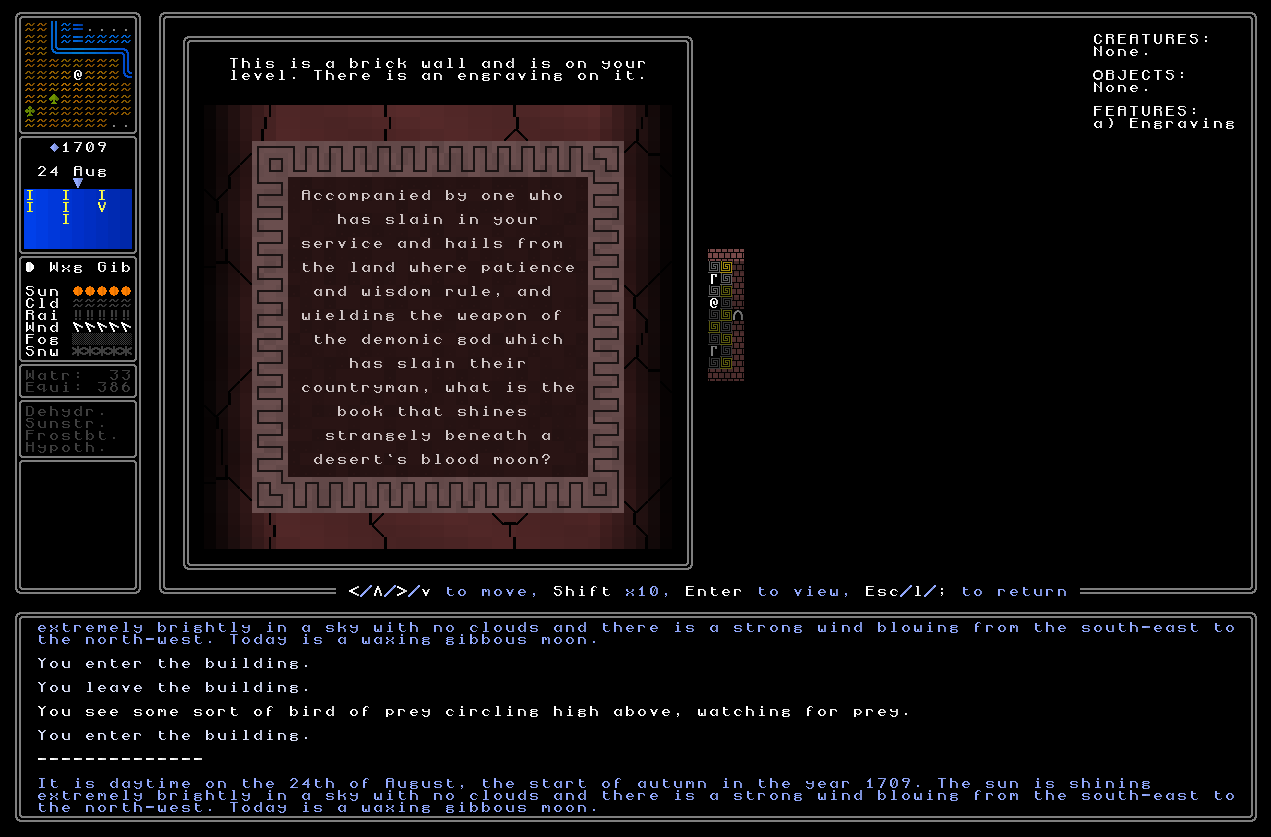
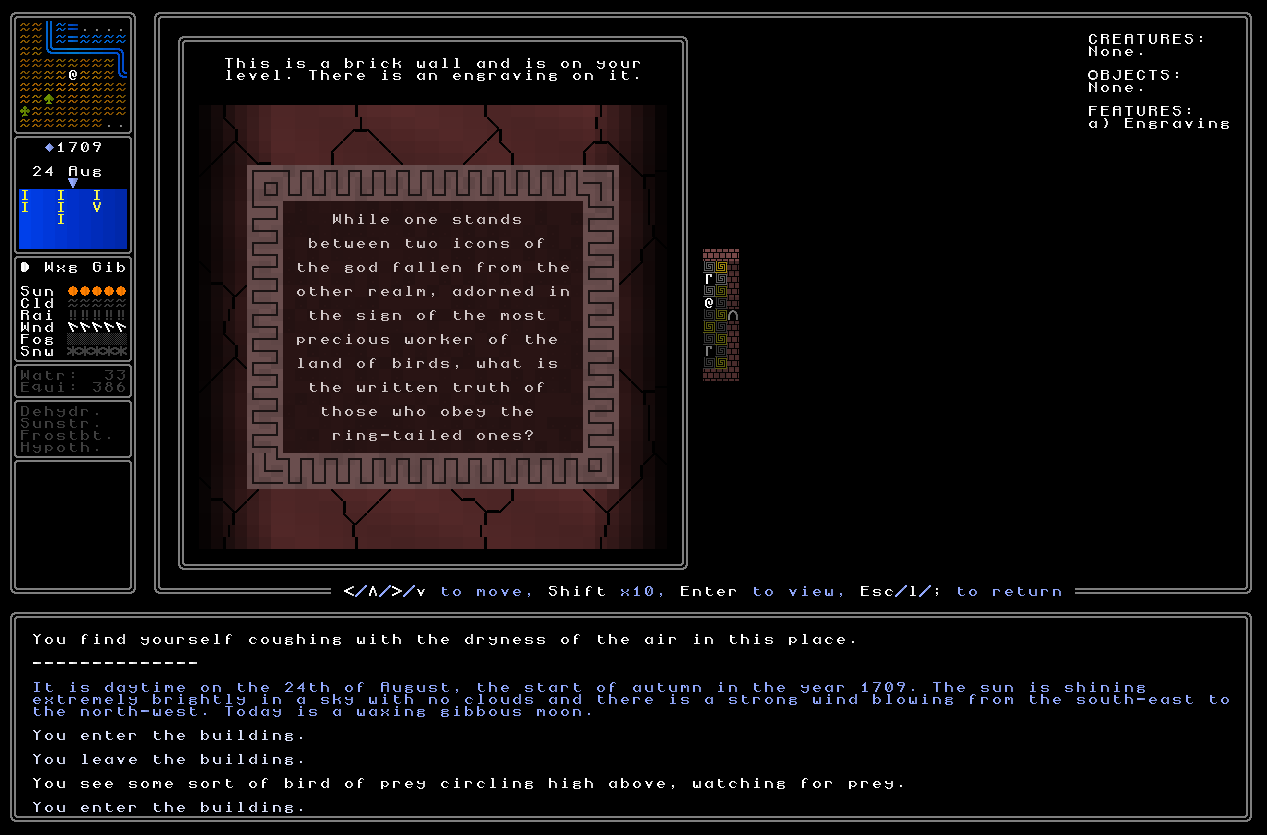
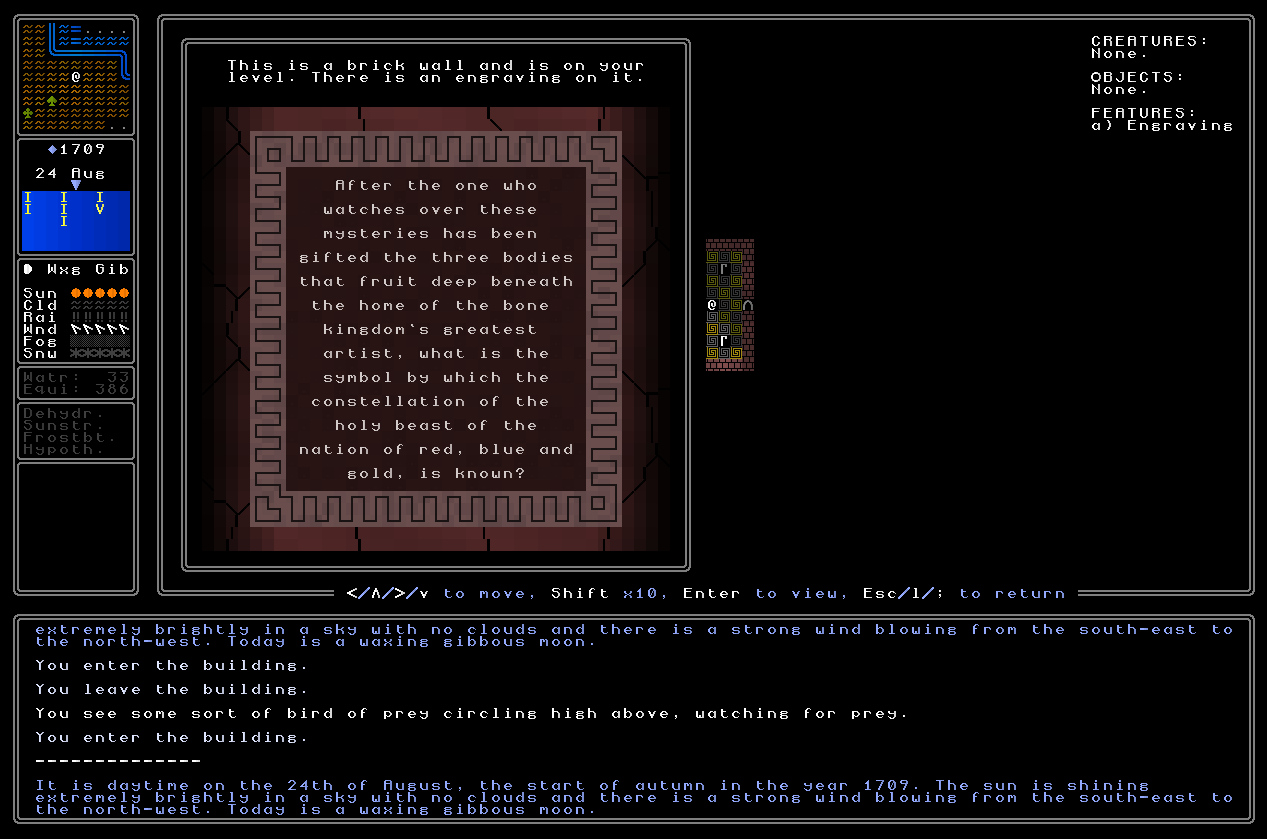
What a weird place.
Release schedule
Lastly, I’ve been thinking a lot about my release schedule. Right now we’re on 0.10.2 and I certainly have enough new stuff here for a 0.10.3, or indeed a 0.11. The issue is that I see a number of potential options here, especially as I want the next major release to have at least a core win condition – i.e. some generated riddles – but I also don’t want it to take too long to be released. This is a tricky combination because the really truly demanding stuff now is going to begin the proper generation of riddles and clues and their integration with the world, treasure maps, conversations, everything else… but I also don’t want this version to go too long if I can help it. At the same time though, after 13 years of very worldbuilding-heavy releases, I am very reluctant to make 0.11 “another” release in that ilk – even if it comes with the religious quests – rather than having some kind of core objective. I’ve been doing a lot of thinking about this, including a lot of talking to myself while out for long walks (the only way to get some sensible advice around here), and I’ve concluded that there are basically three options:
1) Release a 0.11 soon-ish with all the additions I’ve put into place now, and then focus exclusively on riddle / quest generation for 0.12.
2) Release a 0.10.3 with lots of the additions I’ve put in, but hold off on 0.11 until I can further develop treasure maps and add some major riddle generators into the game to connect with them, allowing for one main questline ending in finding a buried treasure location (as opposed to very many, as intended in the longer term).
3) The same as #2, but with more questlines (so don’t just release with a single map / riddle set to solve, but a whole bunch).
After a lot of consideration, I think #1 just isn’t viable. This is for the reason described above – I think the next major release simply has to have a core objective, a core quest. It would be so easy to just release another release without that, but although the worldbuilding is the foundation of the gameplay, I think it is time to really focus in on getting a basic version – a “vertical”, to use the industry terminology – of starting the game, and completing the game, going. Even if things are going to become far more complex in the future, I think this is the goal. But the problem is: treasure maps by themselves are not enough too build a full quest around…
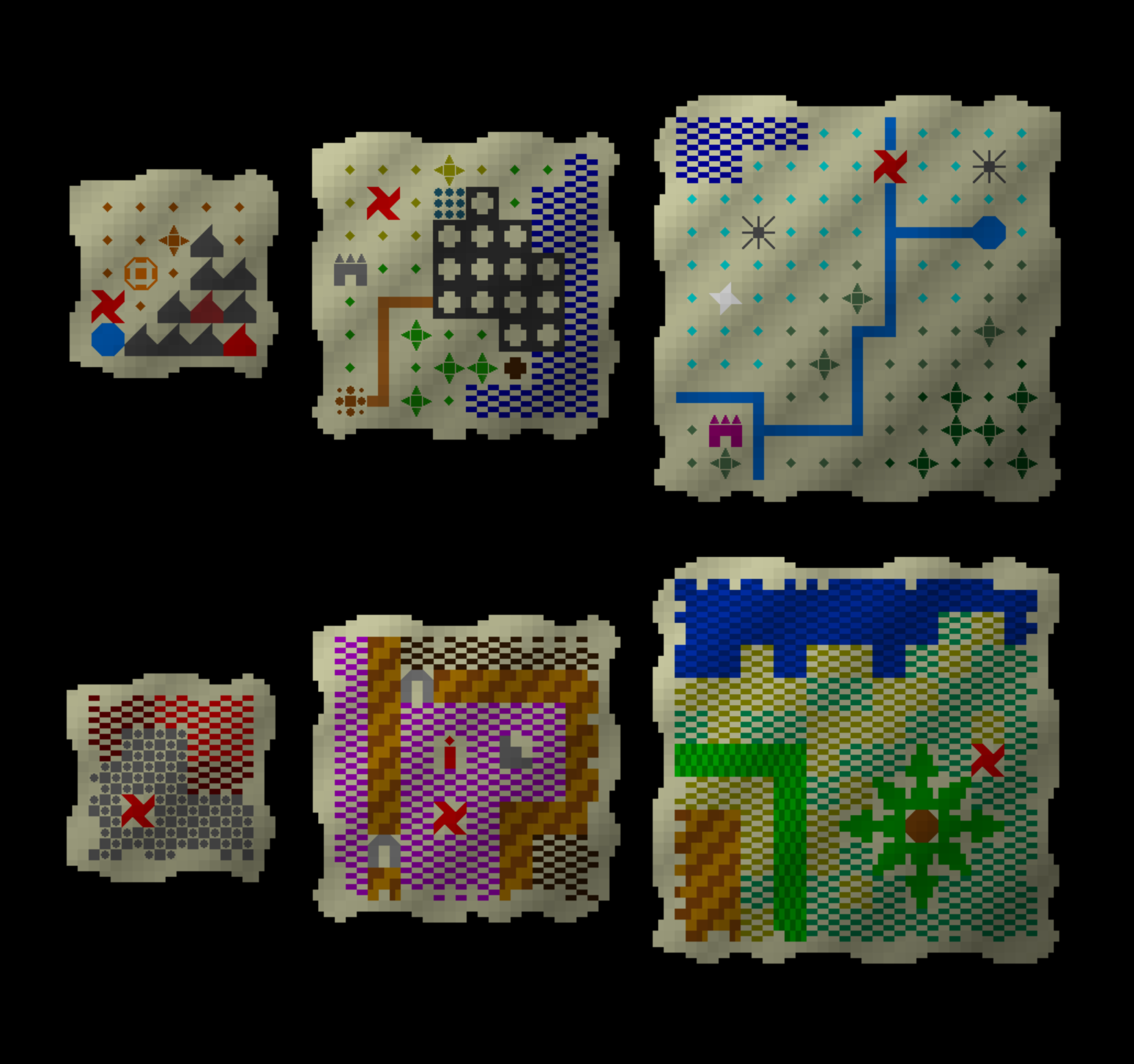
…and that means that although the treasure maps are mostly completed, more of the riddle generation stuff needs to be there for even one viable example of a core quest thread. Like all the generated note types and every other source of data (books, people, observation, notes, etc), they’re ultimately designed to be used together, not on their own. This does inevitably mean that at least some other elements have to be present… but let’s get to that when we get to that. I’m not yet sure whether I’m going to do #2 (release with one quest thread) or #3 (release a little later with several quest threads), but I don’t think #1 is an option. I will, however, release a 0.10.3 at some point! That would be really useful to get feedback and bug hunting from people, so if you’re interested, as ever, either leave a message here or send me an email if you want to be one of the first people to explore what the religions can do for you :).
Anyway, the upshot is – the next major release will have one vertical slice of a complete riddle chain, at the very minimum. This is quite exciting! More soon on this…
What next?
Well, I’m sticking to triweekly updates (fortnightly remains ambitious, but this feels very doable at the moment), so given that this is being published on June 9th, so you can expect the next post on June 30th.
As ever, please do post any thoughts you have (I always love to hear everyone’s feedback), share it with other roguelike-likers if you think this is a particularly cool update, and with all said and done, I’ll see you all at the end of the month!
Thanks so much for reading, everyone :).
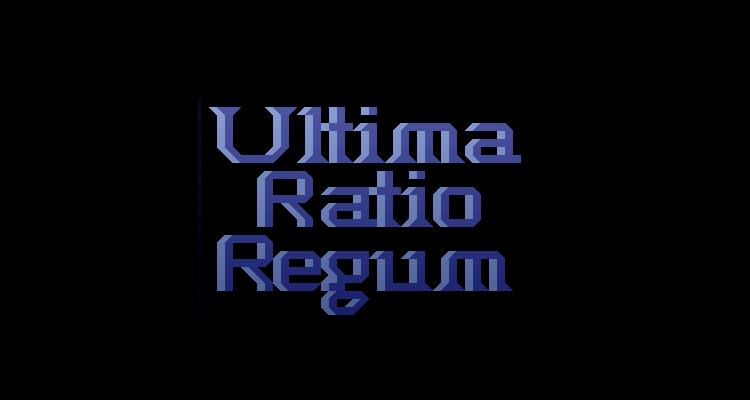
I like the progress so far and am really excited to see what route the religions go. If you’re looking for testers I’d be happy to offer some feedback on version 0.10.13
Jano, thank you! And absolutely, thank you so much for the offer – I’ll send you an email once it’s testing time :).
Wow, this update! Besides astonishing details of the sphinx-house… I experienced something otherwordly looking at the treasure map awakened something… kinda from early childhood IDK… feeling that it’s not just another random texture but something deeply meaningful and cosmic…
Thanks dreamer, I’m so glad you like it! And, ooh, I’m intrigued. I’m definitely trying to evoke something of lots of childhood games I enjoyed where there were deeper mysteries, or one didn’t have complete information, or there were clues in the manual, or…
This game is looking more and more fascinating with every blog post. I’ve never done more than light dabbling so far; I’m really interested in the idea of a “win condition” approaching.
This. Even without combat, this update will actually turn URR into a *real* game. A very chill, fascinating one. Hope Mark does follow through and finishes this thing, could (easily) be the most legendary open world roguelike ever made.
Thank you for *such* a kind comment saint :). I do very much hope that everything you wrote comes to pass!
Ash, thanks so much for such a kind message! Yes, me too – it’s definitely about time. It couldn’t exist *without* the mega-detailed world, but now that that world is present (though, of course, more details are planned), it’s time to get that vertical slice in and start properly testing how it all plays out.
Wow, really neat, I like the ideas of the new dialogue system! I think in the old system there were too few general questions, asking about the surrounding, for directing to buildings by building type (shop, library, etc.) with the new systems those could be not only questions player can ask but also once NPC can ask player about. Ah, and for the art chats I think it would be interesting if NPCs can ask follow up questions, like if player asks NPC about book X NPC could follow up with a question “Is it a book where Y happens or Z happens?” And if the player wants to know correct information they would have to remember what happens in the book… Anyway, the system has a lot of potential in such content rich world, keep up the great work!
Thanks so much for the comment Limofeus! I really appreciate it. Yes, absolutely, too few general questions and too few specific questions (somehow?). That’s also a lovely idea, having NPCs “check” the player’s knowledge on things when appropriate – let me think on that one some more!
Those staves look *amazing*, and I especially like how they take aspects of their associated religion with the wings, spirals, etc. I imagine stealing or otherwise acquiring such a staff (perhaps from the body of an inquisitor who unwisely attacked the player) would be very useful in impersonating a high-ranking clergy member, perhaps to get some crucial information or relic. Of course, if you just walk around town carrying such a staff, it might cause some problems…
The new conversation system looks like it’s going to be a significant improvement. It would be hilarious to run around saying a secret code to everyone and perhaps develop a reputation as an eccentric oddball? Characters might then open conversations with something like, “By the gods, I’ve heard about you, please don’t ask me about [code]!” Speaking of which, will individual NPCs in the game have personality traits that come up in conversations? For example, a particular person could be more prone to make jokes, interrupt you, be irritable or belligerent, be kind & helpful, or perhaps be a bit dim (which might limit conversation options ala Fallout 1).
The sphinx house and riddles are intriguing! I very much look forward to playing a vertical slice of URR. Have you considered putting the game on itch.io? I checked but didn’t see it there. It might help it get some more visibility
Crowbar, thank you for such a detailed comment! So glad you like the staves, and yes, definitely – now that the player cannot see information about NPCs they don’t have a logical way of knowing, I certainly intend for the same to be true the other way around, as well (hence the ability to impersonate). This is of course part of the redone conversation system – an NPC, who has never met you, can only respond to you based on what they see…
And, hahahaha, I definitely have an intention for you to be able to get a reputation, and that’ll affect things; it’s nice in a flavour sense, but also has gameplay value, i.e. preventing you from just trying a code, for instance, on everyone you meet. Try on too many and people will stop listening, or if you become truly obnoxious, might become hostile. All the fun I’ve had with games like La-Mulana or the Outer Wilds or Tunic or whatever show that one needs to have ways to prevent, or at least strongly discourage, infinite solution-trying – and this will be one of them. But yeah, individual personality traits for sure! I have a few planned out, and one really cool system it’ll be fun to reveal in a little while, too.
Re: itch, not yet, though I’m open to it. I confess, although I play a few things there, I don’t know a great deal about the platform, especially in terms of legal stuff, and the like. Some research will be needed first, but I’ll definitely think on it for the 0.11 release!